GE PGS968SEMSS User Manual

ge.com (U.S.) www.GEAppliances.ca (Canada)
RangesGas Slide-In
Safety Instructions . . . . . . . . . . . .2–7
Operating Instructions
Baking or Roasting . . . . . . . . . . . . . .11 Broiling, Broiling Guide . . . . . . . . .14 Clock and Timer . . . . . . . . . . . . . . .15 Control Lockout . . . . . . . . . . . . . . .15 Convection . . . . . . . . . . . . . . . . .18–22 Cookware . . . . . . . . . . . . . . . . . . . . . .9 Oven . . . . . . . . . . . . . . . . . . . . . .10–30 Probe . . . . . . . . . . . . . . . . . . . . . . . .17 Proofing . . . . . . . . . . . . . . . . . . . . . .23 Sabbath Feature . . . . . . . . . . . . . . . .30 Self-Cleaning . . . . . . . . . . . . . . .25, 26 Special Features . . . . . . . . . . . . .27–29 Surface Burners . . . . . . . . . . . . . . 8, 9 Thermostat . . . . . . . . . . . . . . . . . . . .24 Timed Baking & Roasting . . . . . . . .16 Warming . . . . . . . . . . . . . . . . . . . . . .23
Care and Cleaning
Burner Assembly . . . . . . . . . . . . . . . 31
Burner Grates and
Vent Grille . . . . . . . . . . . . . . . . . . . . 32
Control Panel . . . . . . . . . . . . . . . . . 35
Door . . . . . . . . . . . . . . . . . . . . . . . . . 34
Floor . . . . . . . . . . . . . . . . . . . . . . . . .35
Glass Cooktop . . . . . . . . . . . . . . 36, 37
Knobs . . . . . . . . . . . . . . . . . . . . . . . . 31
Write the model and serial numbers here:
Model # ______________
Serial # ______________
You can find them on a label behind the open oven door on the lower left corner of the range frame.
Owner’s Manual
JGS968
PGS968
Lift-Off Oven Door . . . . . . . . . . . . .34
Light Bulbs . . . . . . . . . . . . . . . . . . . .32
Packaging Tape . . . . . . . . . . . . . . . .31
Painted Surfaces . . . . . . . . . . . . . . . .35
Racks . . . . . . . . . . . . . . . . . . . . . . . . 33
Stainless Steel Surfaces . . . . . . . . . .35
Storage Drawer . . . . . . . . . . . . . . . . 33
Vent . . . . . . . . . . . . . . . . . . . . . . 32, 35
Troubleshooting Tips . . . . . . . 38–42
Accessories . . . . . . . . . . . . . . . . . . . 47
Consumer Support
Consumer Support . . . . . Back Cover Product Registration
(Canada) . . . . . . . . . . . . . . . . . . 45, 46 Product Registration (U.S.A.) . 43, 44 Warranty for Customers
in Canada . . . . . . . . . . . . . . . . . . . . 51 Warranty for Customers
in the U.S.A. . . . . . . . . . . . . . . . . . . 50
49-80496 07-07 JR
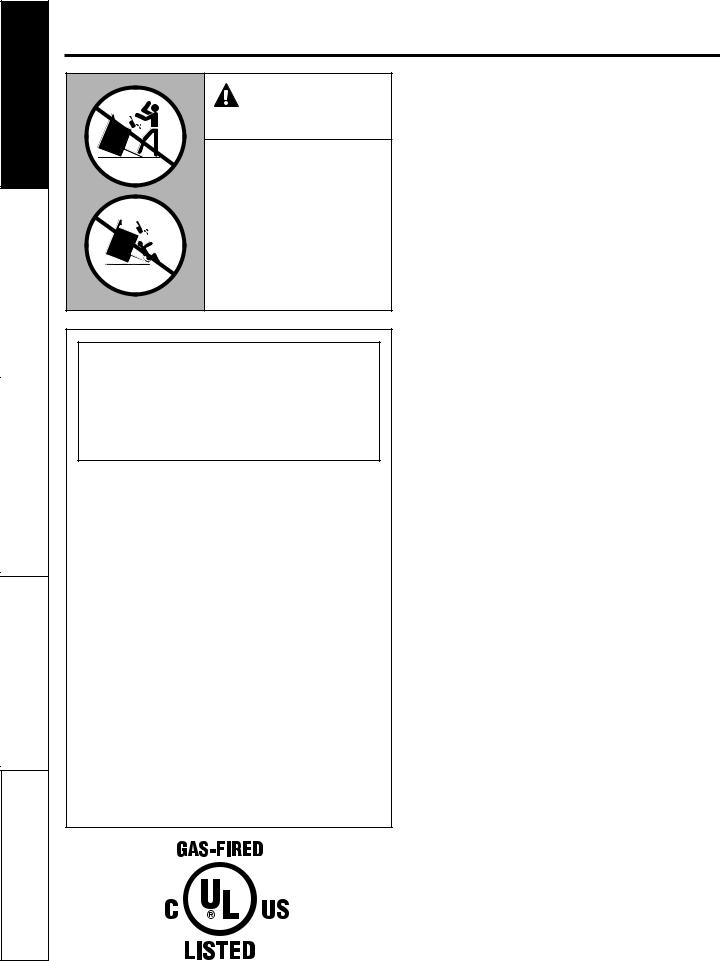
Consumer Support Troubleshooting Tips Care and Cleaning Operating Instructions Safety Instructions
IMPORTANT SAFETY INFORMATION. READ ALL INSTRUCTIONS BEFORE USING.
WARNING! |
ANTI-TIP DEVICE |
■ ALL RANGES CAN TIP |
■ INJURY TO PERSONS |
COULD RESULT |
■ INSTALL ANTI-TIP |
DEVICES PACKED WITH |
RANGE |
■ SEE INSTALLATION |
INSTRUCTIONS |
 WARNING: If the information in this manual is not followed exactly, a fire or explosion may result causing property damage, personal injury
WARNING: If the information in this manual is not followed exactly, a fire or explosion may result causing property damage, personal injury
or death.
—Do not store or use gasoline or other flammable vapors and liquids in the vicinity of this or any other appliance.
—WHAT TO DO IF YOU
SMELL GAS
■Do not try to light any appliance.
■Do not touch any electrical switch;
do not use any phone in your building.
■Immediately call your gas supplier from a neighbor’s phone. Follow the gas supplier’s instructions.
■If you cannot reach your gas supplier, call the fire department.
—Installation and service must be performed by a qualified installer, service agency or the gas supplier.
2
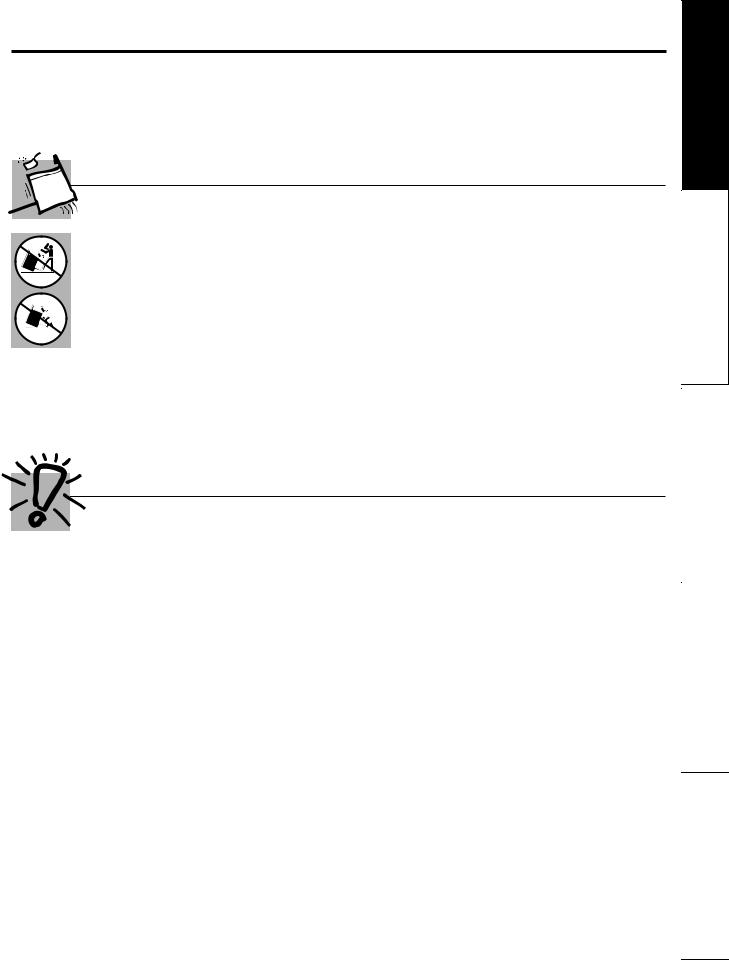
ge.com (U.S.) www.GEAppliances.ca (Canada)
 WARNING!
WARNING!
For your safety, the information in this manual must be followed to minimize the risk of fire or explosion, electric shock, or to prevent property damage, personal injury, or loss of life.
ANTI-TIP DEVICE
All ranges can tip and injury could result.
To prevent accidental tipping of the range, attach it to the wall or floor by installing the Anti-Tip device supplied.
If the Anti-Tip device supplied with the range does not fit this application, use the universal Anti-Tip device WB2X7909.
To check if the device is installed and engaged properly, remove the storage drawer and inspect the rear leveling leg. Make sure it fits securely into the slot.
If you pull the range out from the wall for any reason, make sure the device is properly engaged when you push the range back against the wall. If it is not, there is a possible risk of the range tipping over and causing injury if you or a child stand, sit or lean on an open door.
Please refer to the Anti-Tip device information in this manual. Failure to take this precaution could result in tipping of the range and injury.
IMPORTANT SAFETY NOTICE
The California Safe Drinking Water and Toxic Enforcement Act requires the Governor of California to publish a list of substances known to the state to cause birth defects or other reproductive harm, and requires businesses to warn customers of potential exposure to such substances.
Gas appliances can cause minor exposure to four of these substances, namely benzene, carbon monoxide, formaldehyde and soot, caused primarily by the incomplete combustion of natural gas or LP fuels. Properly adjusted burners, indicated by a bluish rather than a yellow flame, will minimize incomplete combustion. Exposure to these substances can be minimized by venting with an open window or using a ventilation fan or hood.
The fiberglass insulation in self-clean ovens gives off a very small amount of carbon monoxide during the cleaning cycle. Exposure can be minimized by venting with an open window or using a ventilation fan or hood.
3
Support Consumer Tips Troubleshooting Cleaning and Care Instructions Operating Instructions Safety
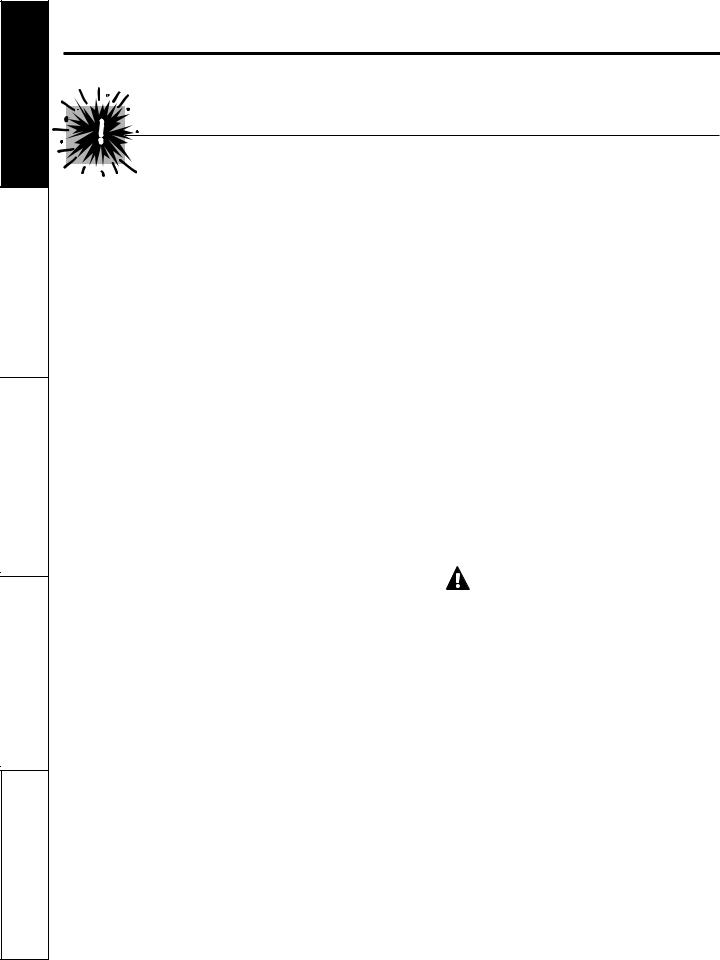
Consumer Support Troubleshooting Tips Care and Cleaning Operating Instructions Safety Instructions
IMPORTANT SAFETY INFORMATION.
READ ALL INSTRUCTIONS BEFORE USING.
 WARNING!
WARNING!
 SAFETY PRECAUTIONS
SAFETY PRECAUTIONS
 When using electrical appliances, basic safety precautions should be followed, including the following:
When using electrical appliances, basic safety precautions should be followed, including the following:
■ Use this appliance only for its intended |
■ Do not attempt to repair or replace any |
|
purpose as described in this Owner’s |
part of your range unless it is specifically |
|
Manual. |
recommended in this manual. All other |
|
■ Be sure your appliance is properly installed |
service should be referred to a qualified |
|
technician. |
||
and grounded by a qualified technician in |
||
|
||
accordance with the provided installation |
■ Be sure your range is correctly adjusted |
|
instructions. |
by a qualified service technician or installer |
|
■ Before performing any service, disconnect |
for the type of gas (natural or LP) that is |
|
to be used. Your range can be converted |
||
the range power supply at the household |
||
for use with either type of gas. See the |
||
distribution panel by removing the fuse or |
||
Installation Instructions packed with |
||
switching off the circuit breaker. |
||
the range. |
||
■ Have the installer show you the location of |
||
■ Plug your range into a 120-volt grounded |
||
the circuit breaker or fuse. Mark it for easy |
||
outlet only. Do not remove the round |
||
reference. |
||
grounding prong from the plug. If in |
||
|
||
■ Do not leave children alone—children |
doubt about the grounding of the home |
|
should not be left alone or unattended in |
electrical system, it is your personal |
|
an area where an appliance is in use. They |
responsibility and obligation to have |
|
should never be allowed to sit or stand on |
an ungrounded outlet replaced with a |
|
any part of the appliance. |
properly grounded, three-prong outlet in |
|
■ Have the installer show you the location |
accordance with the National Electrical |
|
Code (U.S.). Do not use an extension cord |
||
of the range gas shut-off valve and how to |
||
with this appliance. |
||
shut it off if necessary. |
||
WARNING: These adjustments |
||
■ Have your range installed and properly |
||
grounded by a qualified installer, in |
must be made by a qualified service |
|
accordance with the Installation |
technician in accordance with the |
|
Instructions. Any adjustment and service |
manufacturer’s instructions and all codes |
|
should be performed only by qualified gas |
and requirements of the authority having |
|
range installers or service technicians. |
jurisdiction. Failure to follow these |
|
■ Locate the range out of kitchen traffic path |
instructions could result in serious injury or |
|
property damage. The qualified agency |
||
and out of drafty locations to prevent poor |
||
performing this work assumes |
||
air circulation. |
||
responsibility for the conversion. |
||
■ Be sure all packaging materials are |
||
■ Keep the hood and grease filters clean to |
||
removed from the range before operating |
||
maintain good venting and to avoid grease |
||
it to prevent fire or smoke damage should |
||
fires. |
||
the packaging material ignite. |
||
■ Teach children not to play with the |
||
■ Do not leave children alone or unattended |
||
where a range is hot or in operation. They |
controls or any other part of the range. |
|
■ Always keep dish towels, dish cloths, pot |
||
could be seriously burned. |
||
|
holders and other linens a safe distance |
|
|
from your range. |
4

ge.com (U.S.) www.GEAppliances.ca (Canada)
 SAFETY PRECAUTIONS
SAFETY PRECAUTIONS
 ■ Always keep wooden and plastic utensils and canned food a safe distance from your range.
■ Always keep wooden and plastic utensils and canned food a safe distance from your range.
■Always keep combustible wall coverings, curtains or drapes a safe distance from your range.
■Do not clean the range with flammable or volatile cleaning fluids.
■After prolonged use of a range, high floor temperatures may result and many floor coverings will not withstand this kind of use. Never install the range over vinyl tile or linoleum that cannot withstand such type of use. Never install it directly over interior kitchen carpeting.
■Avoid scratching the glass cooktop with sharp instruments, or with rings and other jewelry.
■Do not allow anyone to climb, stand or hang on the oven door, storage drawer or cooktop. They could damage the range and even tip it over, causing severe personal injury.
 CAUTION: Items of interest to children should not be stored in cabinets above a range or on the backsplash of a range—children climbing on the range to reach items could be seriously injured.
CAUTION: Items of interest to children should not be stored in cabinets above a range or on the backsplash of a range—children climbing on the range to reach items could be seriously injured.
 WARNING: NEVER use this
WARNING: NEVER use this
appliance as a space heater to heat or warm the room. Doing so may result in carbon monoxide poisoning and overheating of the cooktop or oven.
■For your safety, never use your appliance for warming or heating the room.
■Large scratches or impacts to glass doors can lead to broken or shattered glass.
■Do not clean the range when the appliance is in use.
■Never wear loose-fitting or hanging garments while using the appliance.
Be careful when reaching for items stored in cabinets over the range. Flammable
material could be ignited if brought in contact with flame or hot oven surfaces and may cause severe burns.
■Do not store flammable materials in an oven, a range storage drawer or near a cooktop.
■Do not store or use combustible materials, gasoline or other flammable vapors and liquids in the vicinity of this or any other appliance.
■Do not let cooking grease or other flammable materials accumulate in or near the range.
■Do not use water on grease fires. Never pick up a flaming pan. Turn the controls off. Smother a flaming pan on a surface burner by covering the pan completely with a well-fitting lid, cookie sheet or flat tray. Use a multi-purpose dry chemical or foam-type fire extinguisher.
■Flaming grease outside a pan can be put out by covering it with baking soda or, if available, by using a multi-purpose dry chemical or foam-type fire extinguisher.
■Flame in the oven can be smothered completely by closing the oven door and turning the control to off or by using a multi-purpose dry chemical or foam-type fire extinguisher.
■Let the burner grates and other surfaces cool before touching them or leaving them where children can reach them.
■Never block the vents (air openings) of the range. They provide the air inlet and outlet that are necessary for the range to operate properly with correct combustion. Air openings are located at the rear of the cooktop, at the top and bottom of the oven door, and at the bottom of the range under the storage drawer or kick panel.
■Do not lift the cooktop. Lifting the cooktop can lead to damage and improper operation of the range.
5
Support Consumer Tips Troubleshooting Cleaning and Care Instructions Operating Instructions Safety
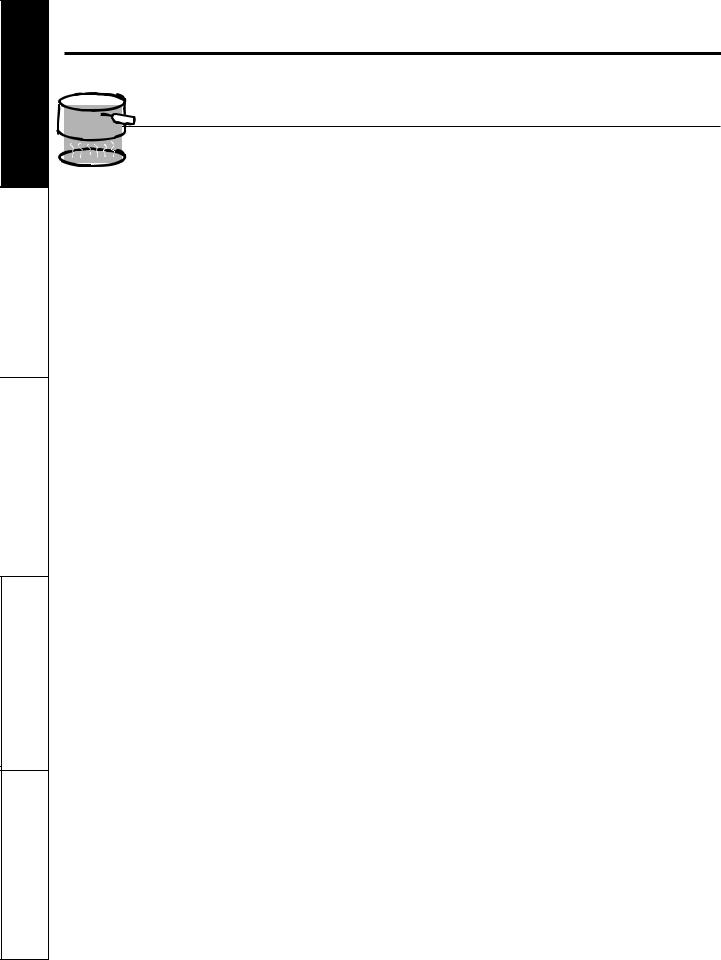
Consumer Support Troubleshooting Tips Care and Cleaning Operating Instructions Safety Instructions
IMPORTANT SAFETY INFORMATION.
READ ALL INSTRUCTIONS BEFORE USING.
 WARNING!
WARNING!
SURFACE BURNERS
Use proper pan size—avoid pans that are unstable or easily tipped. Select cookware having flat bottoms large enough to cover burner grates. To avoid spillovers, make sure cookware is large enough to contain the food properly. This will both save cleaning time and prevent hazardous accumulations of food, since heavy spattering or spillovers left on range can ignite. Use pans with handles that can be easily grasped and remain cool.
■Always use the LITE position when igniting the top burners and make sure the burners have ignited.
■Never leave the surface burners unattended at high flame settings. Boilovers cause smoking and greasy spillovers that may catch on fire.
■Adjust the top burner flame size so it does not extend beyond the edge of the cookware. Excessive flame is hazardous.
■Use only dry pot holders—moist or damp pot holders on hot surfaces may result in burns from steam. Do not let pot holders come near open flames when lifting cookware. Do not use a towel or other bulky cloth in place of a pot holder.
■When using glass cookware, make sure it is designed for top-of-range cooking.
■To minimize the possibility of burns, ignition of flammable materials and spillage, turn cookware handles toward the side or back of the range without extending over adjacent burners.
■Carefully watch foods being fried at a high flame setting.
■Always heat fat slowly, and watch as it heats.
■Do not leave any items on the cooktop. The hot air from the vent may ignite flammable items and will increase pressure in closed containers, which may cause them to burst.
■If a combination of oils or fats will be used in frying, stir together before heating or as fats melt slowly.
■Use a deep fat thermometer whenever possible to prevent overheating fat beyond the smoking point.
■Do not operate the burner without all burner parts in place.
■Use the least possible amount of fat for effective shallow or deep-fat frying. Filling
6
■the pan too full of fat can cause spillovers when food is added.
■When preparing flaming foods under the hood, turn the fan on.
■Do not use a wok on the cooking surface if the wok has a round metal ring that is placed over the burner grate to support the
wok. This ring acts as a heat trap, which may damage the burner grate and burner head. Also, it may cause the burner to work improperly. This may cause a carbon monoxide level above that allowed by current standards, resulting in a health hazard.
■Foods for frying should be as dry as possible. Frost on frozen foods or moisture on fresh foods can cause hot fat to bubble up and over the sides of the pan.
■Never try to move a pan of hot fat, especially a deep fat fryer. Wait until the fat is cool.
■Do not leave plastic items on the cooktop— they may melt if left too close to the vent.
■Keep all plastics away from the surface burners.
■To avoid the possibility of a burn, always be certain that the controls for all burners are at the OFF position and all grates are cool before attempting to remove them.
■If range is located near a window, do not hang long curtains that could blow over the surface burners and create a fire hazard.
■If you smell gas, turn off the gas to the range and call a qualified service technician. Never use an open flame to locate a leak.
■Always turn the surface burner controls off before removing cookware.
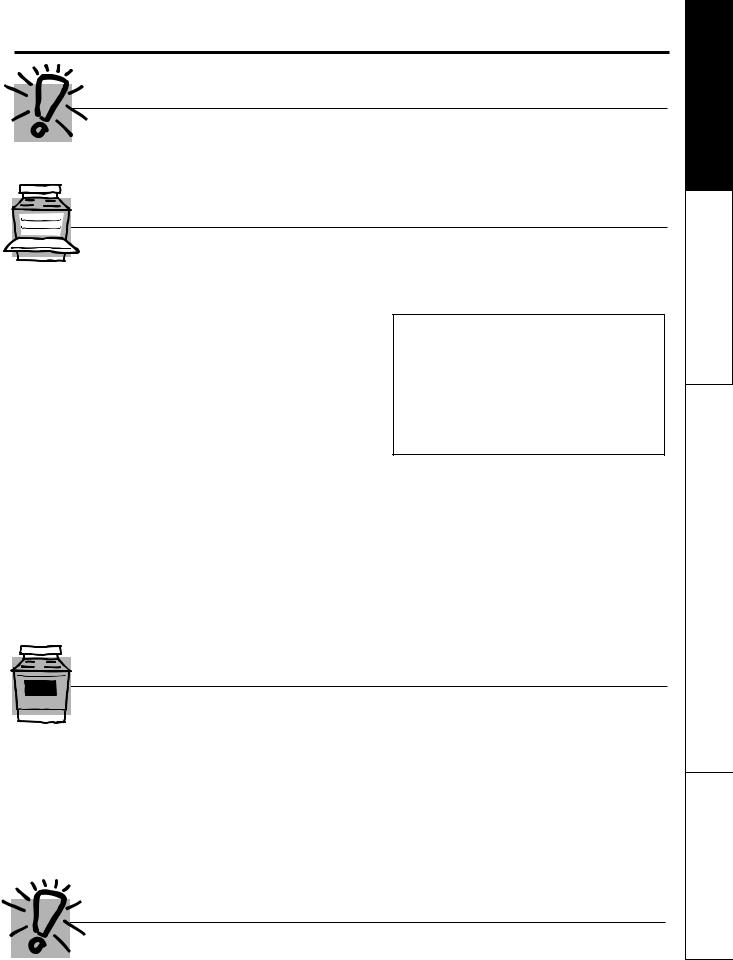
ge.com (U.S.) www.GEAppliances.ca (Canada)
COOK MEAT AND POULTRY THOROUGHLY…
(Cook meat and poultry thoroughly—meat to at least an INTERNAL temperature of 160°F (71°C) and poultry to at least an INTERNAL temperature of 180°F (82°C). Cooking to these temperatures usually protects against foodborne illness.
 WARNING!
WARNING!
OVEN
Stand away from the range when opening the oven door. Hot air or steam which escapes can cause burns to hands, face and/or eyes.
■Do not heat unopened food containers. Pressure could build up and the container could burst, causing an injury.
■Keep the oven vent unobstructed.
■Keep the oven free from grease buildup.
■Place the oven rack in the desired position while the oven is cool. If racks must be handled when hot, do not let pot holder contact the heating elements.
■When using cooking or roasting bags in the oven, follow the manufacturer’s directions.
■Pulling out the rack to the stop-lock is a convenience in lifting heavy foods. It is also a precaution against burns from touching hot surfaces of the door or oven walls.
■Do not use the oven to dry newspapers. If overheated, they can catch on fire.
■Do not use the oven for a storage area. Items stored in an oven can ignite.
■Do not leave paper products, cooking utensils or food in the oven when not in use.
 WARNING: NEVER cover
WARNING: NEVER cover
any slots, holes or passages in the oven bottom or cover an entire rack with materials such as aluminum foil. Doing so blocks air flow through the oven and may cause carbon monoxide poisoning. Aluminum foil linings may also trap heat, causing a fire hazard.
■Do not use aluminum foil to line oven bottoms. Improper installation of aluminum foil may result in a risk of electric shock or fire.
■Make sure a broiler pan is in place correctly to reduce the possibility of grease fires.
■If you should have a grease fire in a broiler pan, press the CLEAR/OFF pad and keep the oven door closed to contain fire until it burns out.
SELF-CLEANING OVEN
Do not use oven cleaners. No commercial oven cleaner or oven liner protective coating of any kind should be used in or around any part of the oven. Residue from oven cleaners will damage the inside of the oven when the self-clean cycle is used.
■Do not clean the door gasket. The door gasket is essential for a good seal. Care should be taken not to rub, damage or move the gasket.
■Before self-cleaning the oven, remove shiny, silver-colored oven racks (on some models) and all other cookware.
■Be sure to wipe up excess spillage before starting the self-cleaning operation.
■If the self-cleaning mode malfunctions, turn the oven off and disconnect the power supply. Have it serviced by a qualified technician.
■Clean only parts listed in this Owner’s Manual.
READ AND FOLLOW THIS SAFETY INFORMATION CAREFULLY.
SAVE THESE INSTRUCTIONS |
7 |
Support Consumer Tips Troubleshooting Cleaning and Care Instructions Operating Instructions Safety
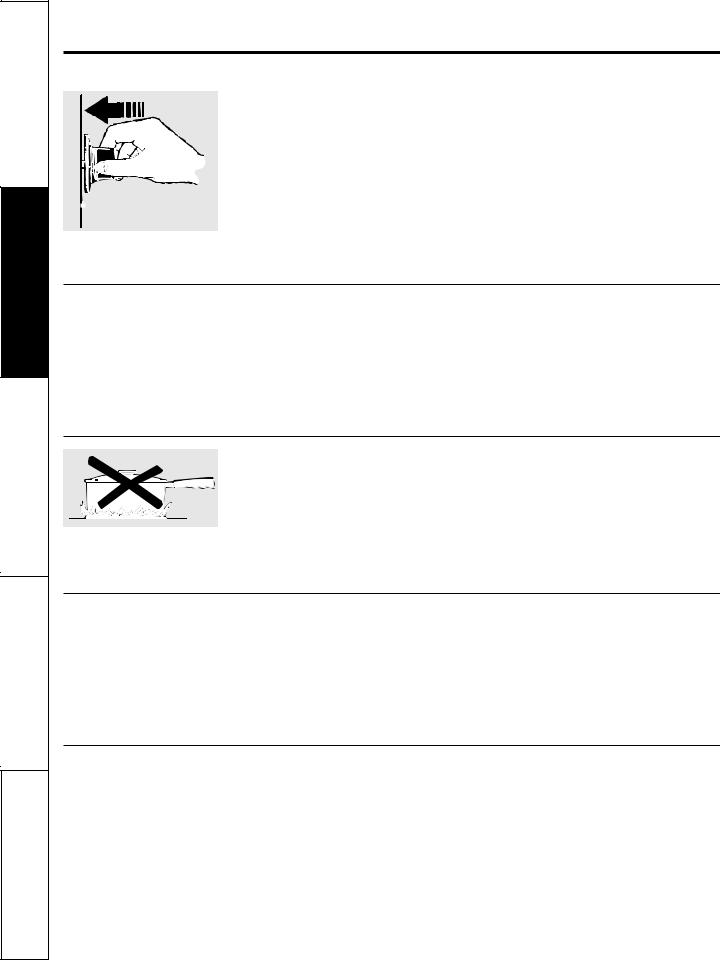
Consumer Support Troubleshooting Tips Care and Cleaning Operating Instructions Safety Instructions
Using the gas surface burners.
Throughout this manual, features and appearance may vary from your model.
Push the control knob in and turn it to the LITE position.
How to Light a Gas Surface Burner
Push the control knob in and turn it to the LITE position.
You will hear a little clicking noise— the sound of the electric spark igniting the burner.
After the flame lights, turn the knob to adjust the flame size. If the knob stays at LITE, it will continue to click.
When one burner is turned to LITE, all the burners spark. Do not attempt to disassemble or clean around any burner while another burner is on. An electric shock may result, which could cause you to knock over hot cookware.
Sealed Gas Burners
The smaller burner (right rear position) will give the best simmer results for delicate foods, such as sauces or foods which need to cook over low heat for a long time. It can be turned down to a very low setting.
The largest burners are higher powered than the others and will bring liquids to a boil quicker.
How to Select Flame Size
For safe handling of cookware, never let the flames extend up the sides of the cookware.
Watch the flame, not the knob, as you reduce heat. The flame size on a gas burner should match the cookware you are using.
Any flame larger than the bottom of the cookware is wasted and only serves to heat the handle.
In Case of Power Failure
In case of a power failure, you can light the gas surface burners on your range with a match. Hold a lit match to the burner, then push in and turn the control knob to the LITE position. Use extreme caution when lighting burners this way.
Surface burners in use when an electrical power failure occurs will continue to operate normally.
Before Lighting a Gas Burner
■Make sure all grates on the range are in place before using any burner.
8
After Lighting a Gas Burner
■Do not operate the burner for an extended period of time without cookware on the grate. The finish on the grate may chip without cookware to absorb the heat.
■Be sure the burners and grates are cool before you place your hand, a pot holder, cleaning cloths or other materials on them.
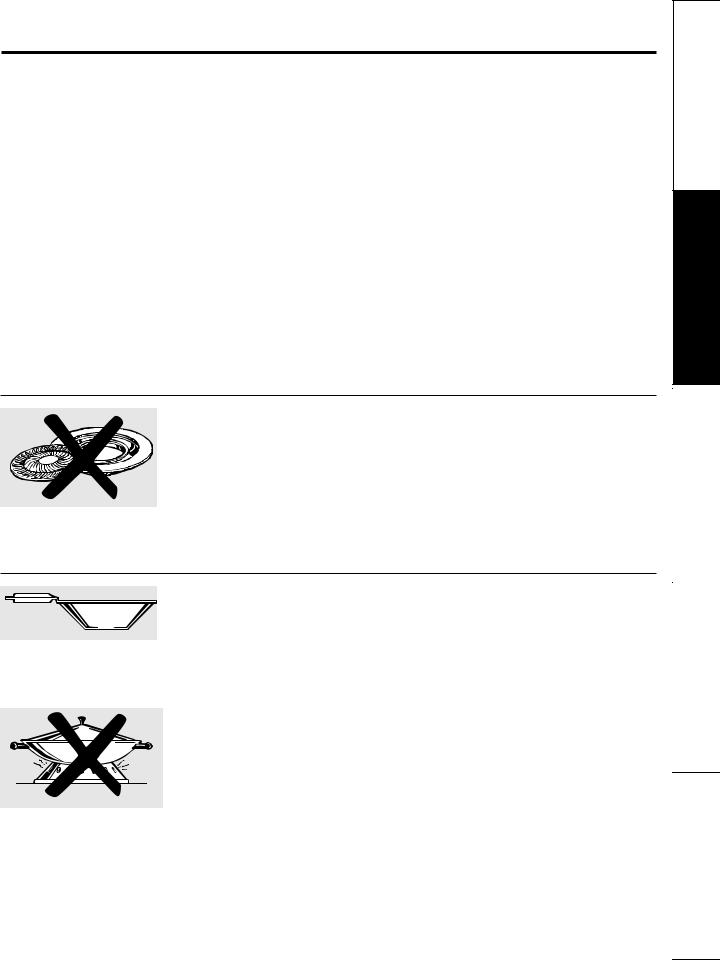
ge.com (U.S.) www.GEAppliances.ca (Canada)
Top-of-Range Cookware
Aluminum: Medium-weight cookware is recommended because it heats quickly and evenly. Most foods brown evenly in an aluminum skillet. Use saucepans with tight-fitting lids when cooking with minimum amounts of water.
Cast-Iron: If heated slowly, most skillets will give satisfactory results.
Enamelware: Under some conditions, the enamel of some cookware may melt. Follow cookware manufacturer’s recommendations for cooking methods.
Glass: There are two types of glass cookware—those for oven use only and those for top-of-range cooking (saucepans, coffee and teapots).
Glass conducts heat very slowly.
Heatproof Glass Ceramic: Can be used for either surface or oven cooking. It conducts heat very slowly and cools very slowly. Check cookware manufacturer’s
directions to be sure it can be used on gas ranges.
Stainless Steel: This metal alone has poor heating properties and is usually combined with copper, aluminum
or other metals for improved heat distribution. Combination metal skillets usually work satisfactorily if they are used with medium heat as the manufacturer recommends.
Stove Top Grills
Do not use stove top grills on your sealed gas burners. If you use the stove top grill on the sealed gas burner, it will cause incomplete combustion and can result in exposure to carbon monoxide levels above allowable current standards.
This can be hazardous to your health.
Wok This Way
We recommend that you use a 14-inch (35.6 cm) or smaller flat-bottomed wok. Make sure the wok
Use a flat-bottomed wok. bottom sits flat on the grate. They are available at your local retail store.
Only a flat-bottomed wok should be used.
Do not use a flat-bottomed wok on a support ring. Placing the ring over the burner or grate may cause the burner to work improperly, resulting in carbon monoxide levels above allowable standards. This could be dangerous to your health.
9
Support Consumer Tips Troubleshooting Cleaning and Care Instructions Operating Instructions Safety
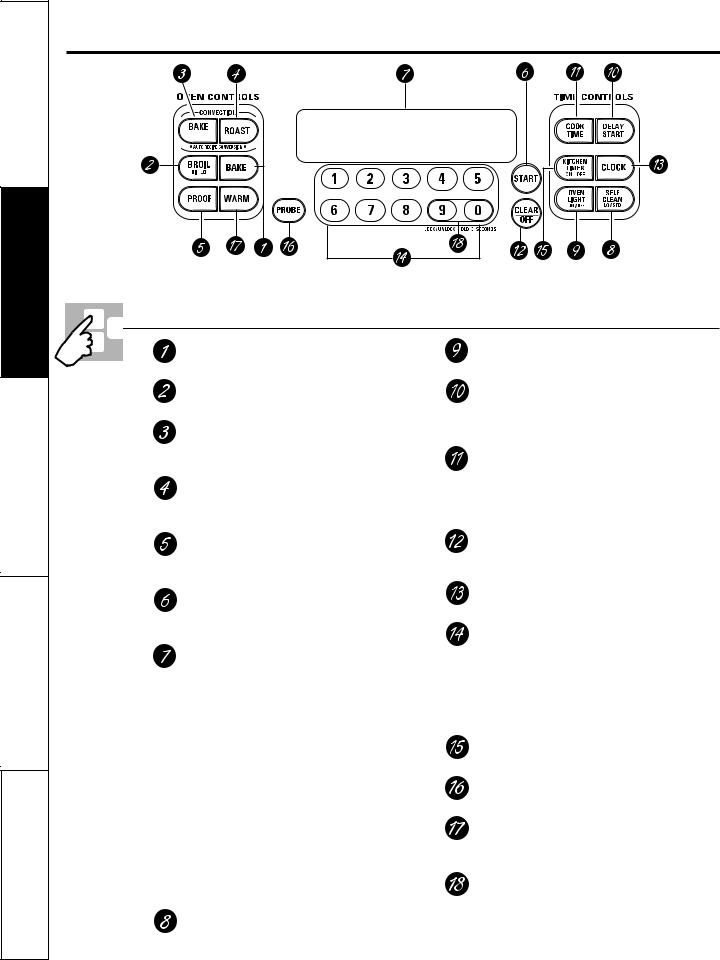
Consumer Support Troubleshooting Tips Care and Cleaning Operating Instructions Safety Instructions
Using the oven controls.
(Throughout this manual, features and appearance may vary from your model.)
MULTI/1 RACK
Features and appearance may vary.
Oven Control, Clock and Timer Features and Settings
BAKE Pad
Touch to select the bake function.
BROIL HI/LO Pad
Touch to select the broil function.
CONVECTION BAKE MULTI/1 RACK Pad
Touch to select baking with the convection function.
CONVECTION ROAST Pad
Touch to select roasting with the convection function.
PROOF Pad
Touch to select a warm environment useful for rising yeast-leavened products.
START Pad
Must be touched to start any cooking or cleaning function.
Display
Shows the time of day, oven temperature, whether the oven is in the bake, broil or self-cleaning mode and the times set for the timer or automatic oven operations.
OVEN LIGHT ON/OFF Pad
Touch to turn the oven light on or off.
DELAY START Pad
Use along with COOK TIME or SELF CLEAN LO/STD pads to set the oven to start and stop automatically at a time you set.
COOK TIME Pad
Touch and then touch the number pads to set the amount of time you want your food to cook. The oven will shut off when the cooking time has run out.
CLEAR/OFF Pad
Touch to cancel ALL oven operations except the clock, timer and control lockout.
CLOCK Pad
Touch before setting the clock.
Number Pads
Use to set any function requiring numbers such as the time of day on the clock, the timer, the oven temperature, the internal food temperature, the start time and length of operation for timed baking
and self-cleaning.
|
If “F– and a number or letter” flash in the display and |
|
the oven control signals, this indicates a function error |
|
code. Touch the CLEAR/OFF pad. Allow the oven to cool for |
|
one hour. Put the oven back into operation. If the function error |
|
code repeats, disconnect the power to the oven and call for |
|
service. |
|
If your oven was set for a timed oven operation and a |
|
power outage occurred, the clock and all programmed |
|
functions must be reset. |
|
The time of day will flash in the display when there has |
|
been a power outage. |
|
SELF CLEAN LO/STD Pad |
10 |
Touch to select self-cleaning function. See the |
Using the self-cleaning oven section. |
KITCHEN TIMER ON/OFF Pad
Touch to select the timer feature.
PROBE Pad
Touch when using the probe to cook food.
WARM Pad
Touch to keep cooked foods warm. See the
How to Set the Oven for Warming section.
CONTROL LOCKOUT
The control lockout is 9 and 0. Touch and hold the 9 and 0 pads at the same time for 3 seconds.
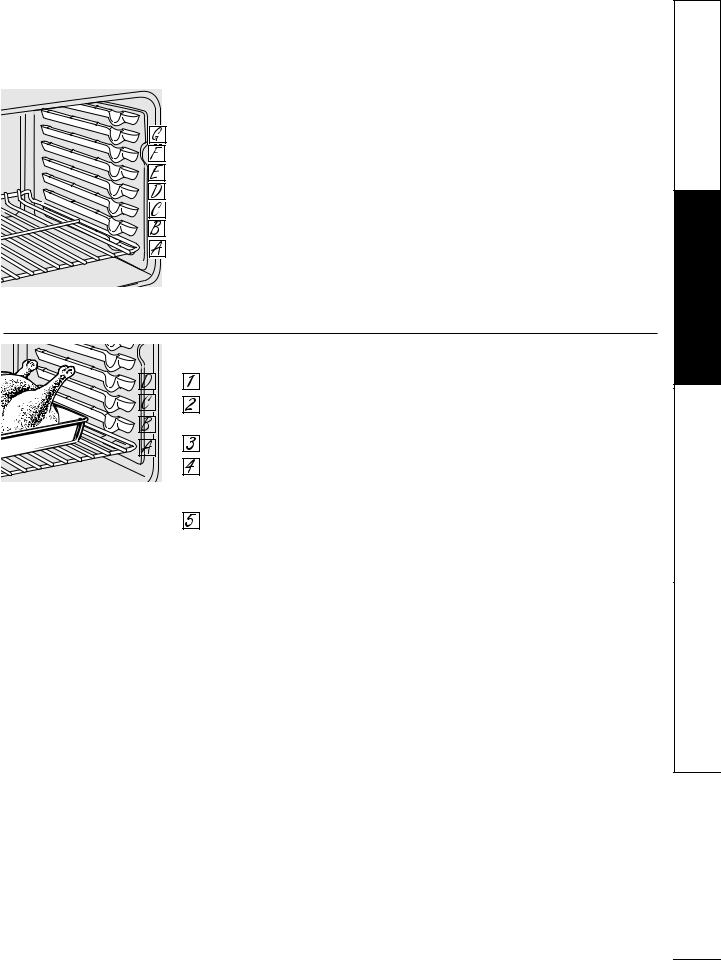
Using the oven. |
ge.com (U.S.) |
www.GEAppliances.ca (Canada) |
To avoid possible burns, place the racks in the desired position before you turn the oven on.
Before you begin…
The racks have stops, so that when placed correctly on the supports, they will stop before coming completely out, and will not tilt.
When placing and removing cookware, pull the rack out until it stops.
The bake burner is under the oven floor. Do not place foods on the oven bottom for cooking.
To remove a rack, pull it toward you,
tilt the front end up and pull it out.
The oven has 7 rack positions.
To replace, place the end of the rack (stop-locks) on the support, tilt up the front and push the rack in.
CAUTION: When you are using the rack in the lowest position (A), you will need to use caution when pulling the rack out. We recommend that you pull the rack out several inches and then, using two pot holders, pull the rack out by holding the sides of it. The rack is low and you could be burned if you place your hand in the middle of the rack and pull all the way out. Be very careful not to burn your hand on the door when using the rack in the lowest position (A).
How to Set the Oven for Baking or Roasting
|
|
|
Touch the BAKE pad. |
|
Type of Food |
Rack Position |
|
|
|
|
Touch the number pads to set |
|
Frozen pies (on cookie sheet) |
C or D |
|
|
|
|
|
||||
|
|
|
|
||||
|
|
|
the desired temperature. |
|
Angel food cake |
A |
|
|
|
|
|
||||
|
|
|
|||||
|
|
|
|
|
|||
|
|
|
Touch the START pad. |
|
Bundt or pound cakes |
B or C |
|
|
|
|
|||||
|
|
||||||
|
|
|
|
|
|||
|
|
|
Check food for doneness at |
|
Biscuits, muffins, brownies, |
C or D |
|
|
|
||||||
|
|
|
minimum time on recipe. Cook |
|
cookies, cupcakes, |
|
|
|
|
|
longer if necessary. |
|
layer cakes, pies |
|
|
|
|
|
Touch the CLEAR/OFF pad when |
|
Casseroles |
C or D |
|
|
|
|
cooking is complete. |
|
Turkey |
A |
|
|
|
|
NOTE: A cooling fan will automatically turn on |
If baking four cake layers at the same time, |
|||
|
|
|
and off to cool internal parts. This is normal, and |
place two layers on rack B and two layers on |
|||
|
|
|
the fan may continue to run even after the oven |
rack D. Stagger pans on the rack so one is |
|||
|
|
|
in turned off. |
not directly above the other. |
|
|
|
11
Support Consumer Tips Troubleshooting Cleaning and Care Instructions Operating Instructions Safety
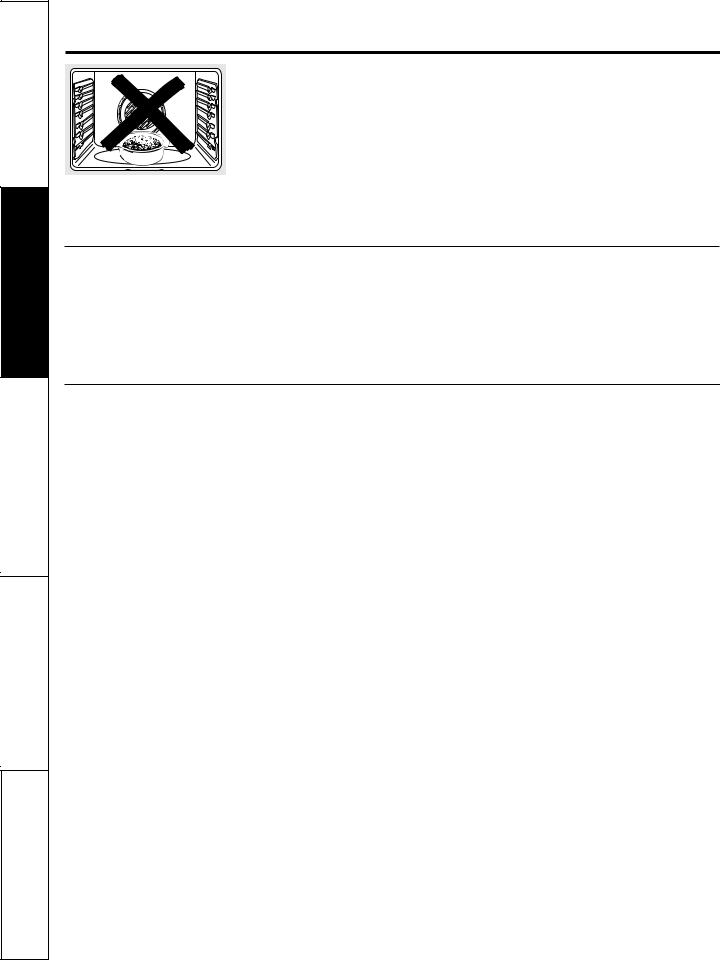
Consumer Support Troubleshooting Tips Care and Cleaning Operating Instructions Safety Instructions
Using the oven.
Do not place foods directly on the oven floor.
Preheating and Pan Placement
Preheat the oven if the recipe calls for it. Preheating is necessary for good results when baking cakes, cookies, pastry and breads.
To preheat, set the oven at the correct temperature. The control will beep when the oven is preheated and the display will show your set temperature.
The preheat time will vary depending on the temperature setting.
Baking results will be better if baking pans are centered in the oven as much as possible. If baking with more than one
pan, place the pans so each has at least 1″ (2.5 cm) to 11⁄2″ (3.8 cm) of air space
around it.
Aluminum Foil
Do not use aluminum foil on the bottom of the oven.
Never entirely cover a rack with aluminum foil. This will disturb the heat circulation and result in poor baking.
A smaller sheet of foil may be used to catch a spillover by placing it on a lower rack several inches below the food.
Oven Moisture
As your oven heats up, the temperature change of the air in the oven may cause water droplets to form on the door glass. These droplets are harmless and will evaporate as the oven continues to
heat up.
12

ge.com (U.S.) www.GEAppliances.ca (Canada)
Oven Vent
Your oven is vented through one vent located toward the rear of the range. Do not block this vent when cooking in the oven—it is important that the flow of hot air from the oven and fresh air to the oven burner be uninterrupted. Avoid touching the vent openings or nearby surfaces during oven or broiler operation— they may become hot.
■Handles of pots and pans on the cooktop may become hot if left too close to the vent.
■Do not leave plastic items on the cooktop— they may melt if left too close to the vent.
■Do not leave any items on the cooktop. The hot air from the vent may ignite flammable items and will increase pressure in closed containers, which may cause them to burst.
■Metal items will become very hot if they are left on the cooktop, and could cause burns.
Power Outage
CAUTION: Do not make any attempt to operate the electric ignition oven during an electrical power failure.
The oven or broiler cannot be lit during a power failure. Gas will not flow unless the glow bar is hot.
If the oven is in use when a power failure occurs, the oven burner shuts off and cannot be re-lit until power is restored. This is because the flow of gas is automatically stopped and will not resume when power is restored until the glow bar has reached operating temperature.
13
Support Consumer Tips Troubleshooting Cleaning and Care Instructions Operating Instructions Safety
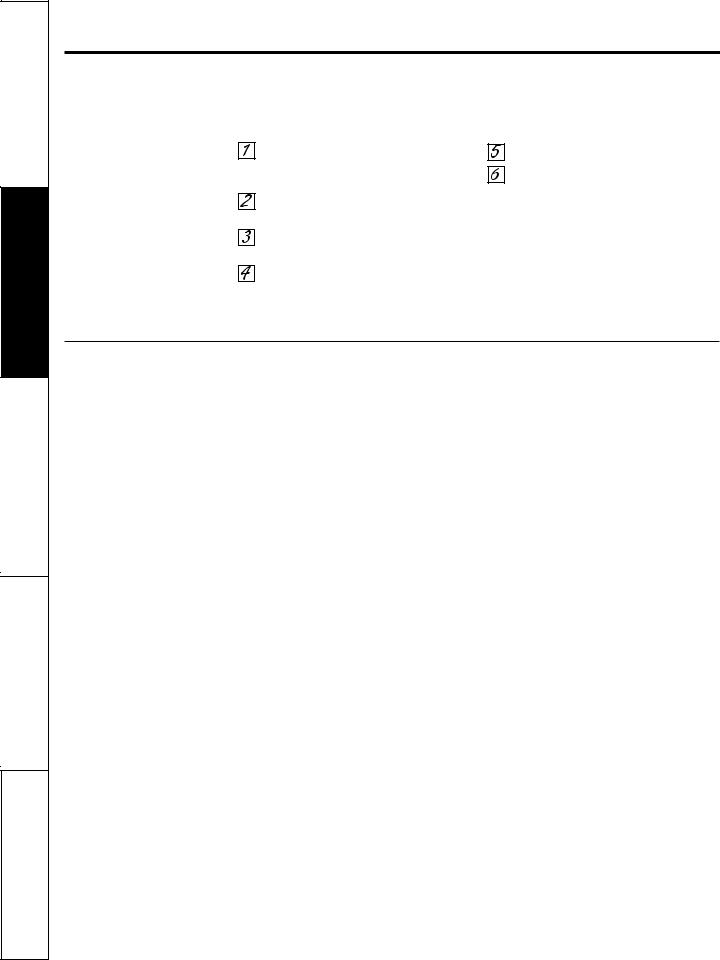
Consumer Support Troubleshooting Tips Care and Cleaning Operating Instructions Safety Instructions
Using the oven.
How to Set the Oven for Broiling
IMPORTANT: To avoid possible burns, place the shelves in the desired position before you turn the oven on.
Place the meat or fish on a broiler grid in a broiler pan designed
for broiling.
Follow suggested shelf positions in the Broiling Guide.
The oven door must be closed during broiling.
Touch the BROIL HI/LO pad once for
HI Broil.
To change to LO Broil, touch the
BROIL HI/LO pad again.
Use LO Broil to cook foods such as poultry or thick cuts of meat thoroughly without over-browning them.
Touch the START pad.
When broiling is finished, touch the
CLEAR/OFF pad.
Serve the food immediately, and leave the pan outside the oven to cool during the meal for easiest cleaning.
NOTE: Broil will not work if the temperature probe is plugged in.
The size, weight, thickness, starting temperature
and your preference of doneness will affect
broiling times. This guide is based on meats at refrigerator temperature.
†The U.S. Department of Agriculture says “Rare beef is popular, but you should know that cooking it to only 140°F (60°C) means some food poisoning organisms may survive.” (Source: Safe Food Book. Your Kitchen Guide. USDA Rev. June 1985.)
14
Broiling Guide
|
Quantity and/ |
Rack |
First Side |
Second Side |
|
Food |
or Thickness |
Position |
Time (min.) |
Time (min.) |
Comments |
|
|
|
|
|
|
Ground Beef |
1/2″ to 3/4″ |
D |
13 |
8 |
Space evenly. |
|
(1.3 cm to 1.9 cm) thick |
|
|
|
|
Beef Steaks |
3/4″ to 1″ |
|
|
|
Steaks less than 3/4″ |
Rare† |
F |
6 |
4 |
||
Medium |
(1.9 cm to 2.5 cm) thick |
E |
8 |
6 |
(1.9 cm) thick are |
Well Done |
1 to 11⁄2 lbs. (0.45 kg to 0.68 kg) |
E |
10 |
8 |
difficult to cook rare. |
Rare† |
11/2″ (3.8 cm) thick |
E |
15 |
10 |
Slash fat. |
|
|||||
Medium |
2 to 21⁄2 lbs. (0.91 kg to 1.13 kg) |
E |
15 |
15 |
|
Well Done |
|
D |
20 |
20 |
|
Chicken |
1 whole cut up |
C |
25 |
25 |
Brush each side with |
|
2 to 21⁄2 lbs. (0.91 kg to 1.13 kg) |
|
|
|
melted butter. |
|
split lengthwise |
|
|
|
Broil skin-side-down |
|
Breast |
C |
25 |
15 |
first. |
Bakery Product |
|
|
|
|
|
Bread (toast) |
2 to 4 slices |
F |
3 |
1 |
Space evenly. Place |
English Muffin |
2 (split) |
F |
3-4 |
|
English muffins cut- |
|
|
|
|
|
side-up and brush |
|
|
|
|
|
with butter if desired. |
Lobster Tails |
2–4 |
C |
18–20 |
Do not |
Cut through back of |
|
|
|
|
turn |
shell. Spread open. |
|
|
|
|
over. |
Brush with melted |
|
|
|
|
|
butter before broiling |
|
|
|
|
|
and after half of |
|
|
|
|
|
broiling time. |
Fish Fillets |
1 lb. (0.45 kg) (1/4″ to 1/2″ |
E |
6 |
6 |
Handle and turn very |
|
[0.6 cm to 1.3 cm] thick) |
|
|
|
carefully. Brush with |
|
|
|
|
|
lemon butter before |
|
|
|
|
|
and during cooking, |
|
|
|
|
|
if desired. |
Salmon |
2 (1″ [2.5 cm] thick) |
|
|
|
|
Steaks |
E |
10 |
5 |
Turn carefully. |
|
Fillets |
2 (1/2″ to 3/4″ |
E |
15 |
|
Do not turn skin-side- |
|
[1.3 cm to 1.9 cm] thick) |
|
|
|
down. |
Ham Slices |
1/2″ (1.3 cm) thick |
D |
8 |
5 |
|
(precooked) |
1″ (2.5 cm) thick |
D |
8 |
8 |
|
Pork Chops |
2 (1/2″ [1.3 cm] thick) |
D |
10 |
10 |
Slash fat. |
Well Done |
2 (1″ [2.5 cm] thick) about |
D |
15 |
5 |
|
|
1 lb. (0.45 kg) |
|
|
|
|
Lamb Chops |
2 (1″ [2.5 cm] thick) about 10 |
|
|
|
|
Medium |
E |
7 |
4 |
Slash fat. |
|
Well Done |
to 12 oz. (283 g to 340 g) |
E |
10 |
9 |
|
Medium |
2 (11⁄2″ [3.8 cm] thick) |
E |
9 |
6 |
|
Well Done |
about 1 lb. (0.45 kg) |
E |
14 |
10 |
|
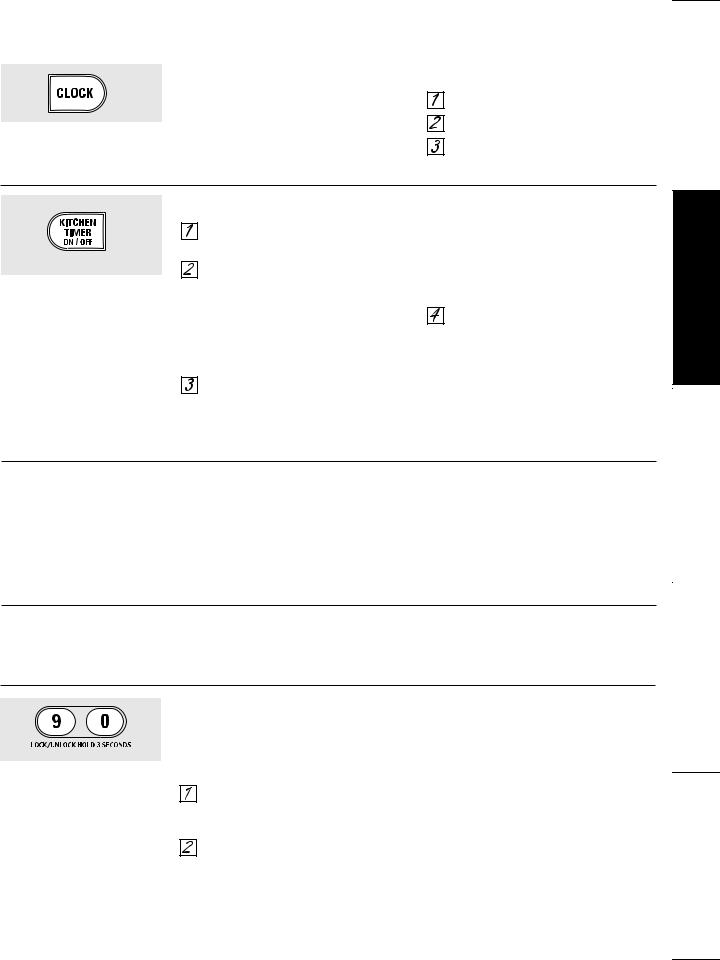
Using the clock, timer and control lockout. |
ge.com (U.S.) |
www.GEAppliances.ca (Canada) |
|
|
|
Make sure the clock is set to the correct time of day.
To Set the Clock
The clock must be set to the correct time of day for the automatic oven timing functions to work properly. The time of day cannot be changed during a timed baking or self-cleaning cycle.
Touch the CLOCK pad.
Touch the number pads.
Touch the START pad.
The timer is a minute timer only.
The timer does not control oven operations. The maximum setting on the timer is 9 hours and 59 minutes.
To Set the Timer
Touch the KITCHEN TIMER
ON/OFF pad.
Touch the number pads until the amount of time you want shows in the display. For example, to set 2 hours and 45 minutes, touch 2, 4 and 5 in that order. If you make a mistake touch the KITCHEN TIMER ON/OFF pad and begin again.
Touch the START pad.
After touching the START pad, SET disappears; this tells you the time is counting down, although the display does not change until one minute has passed. Seconds will not be shown in the display until the last minute is counting down.
When the timer reaches :00, the control will beep 3 times followed by one beep every 6 seconds until the KITCHEN TIMER ON/OFF pad is touched.
The 6-second tone can be canceled by following the steps in the Special features of your oven control section under Tones at the End of a Timed Cycle.
To Reset the Timer
If the display is still showing the time remaining, you may change it by touching the KITCHEN TIMER ON/OFF pad, then touch the number pads until the time you want appears in the display.
If the remaining time is not in the display (clock, delay start or cooking time are in the display), recall the remaining time by touching the KITCHEN TIMER ON/OFF pad and then touching the number pads to enter the new time you want.
To Cancel the Timer
Touch the KITCHEN TIMER ON/OFF pad twice.
Control Lockout
Your control will allow you to lock out the touch pads so they cannot be activated when pressed.
To lock/unlock the controls:
Touch the 9 and 0 pads at the same time for 3 seconds, until the display shows LOC ON.
To unlock the control, touch the 9 and 0 pads at the same time for 3 seconds, until the display shows
LOC OFF.
When this feature is on and the touch pads are touched, the control will beep and the display will show LOC ON.
■The control lockout mode affects all touch pads. No touch pads will work when this feature is activated.
■The adjustment will be retained in memory after a power failure.
15
Support Consumer Tips Troubleshooting Cleaning and Care Instructions Operating Instructions Safety
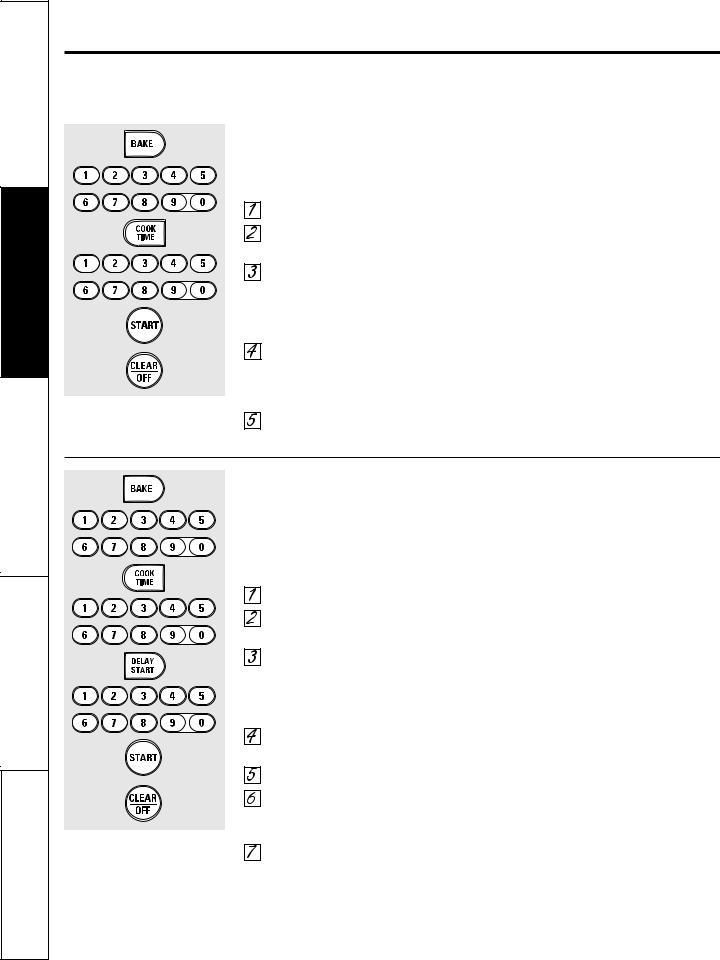
Consumer Support Troubleshooting Tips Care and Cleaning Operating Instructions Safety Instructions
Using the timed baking and roasting features. (on some models)
NOTE: Foods that spoil easily—such as milk, eggs, fish, stuffings, poultry and pork—should not be allowed to sit for more than 1 hour before or after cooking. Room temperature promotes the growth of harmful bacteria. Be sure that the oven light is off because heat from the bulb will speed harmful bacteria growth.
How to Set an Immediate Start and Automatic Stop
The oven will turn on immediately and cook for a selected length of time. At the end of the cooking time the oven will turn off automatically.
Touch the BAKE pad.
Using the number pads, enter the desired temperature.
Touch the COOK TIME pad.
NOTE: If your recipe requires preheating, you may need to add additional time to the length of the cooking time.
Using the number pads, enter the desired baking time. The oven temperature and the cooking time that you entered will be displayed.
Touch the START pad.
The display will show the changing temperature (starting at 100ºF [38ºC]) and the cooking time. The display starts changing once the temperature reaches 100ºF (38ºC).
The oven will continue to cook for the programmed amount of time, then shut off automatically, unless the WARM feature was set. See the How to Set the Oven for Warming section.
Touch the CLEAR/OFF pad to clear the display.
How to Set a Delayed Start and Automatic Stop
You can set the oven control to delay-start the oven, cook for a specific length of time and then turn off automatically.
Make sure the clock shows the correct time of day.
Touch the BAKE pad.
Using the number pads, enter the desired temperature.
Touch the COOK TIME pad.
NOTE: If your recipe requires preheating, you may need to add additional time to the length of the cooking time.
Using the number pads, enter the desired baking time.
Touch the DELAY START pad.
Using the number pads, enter the time of day you want the oven to turn on and start cooking.
Touch the START pad.
If you would like to check the times you have set, touch the DELAY START pad to check the start time you have set or touch the COOK TIME pad to check the length of cooking time you have set.
When the oven turns on at the time of day you have set, the display will show the changing temperature (starting at 100ºF [38ºC]) and the cooking itme. The display starts changing once the temperature reaches 100ºF (38ºC).
The oven will continue to cook for the programmed amount of time, then shut off automatically, unless the WARM feature was set. See the How to Set the Oven for Warming section.
Touch the CLEAR/OFF pad to clear the display.
NOTE: An attention tone will sound if you are using timed baking and do not touch the START pad after entering the baking temperature.
16
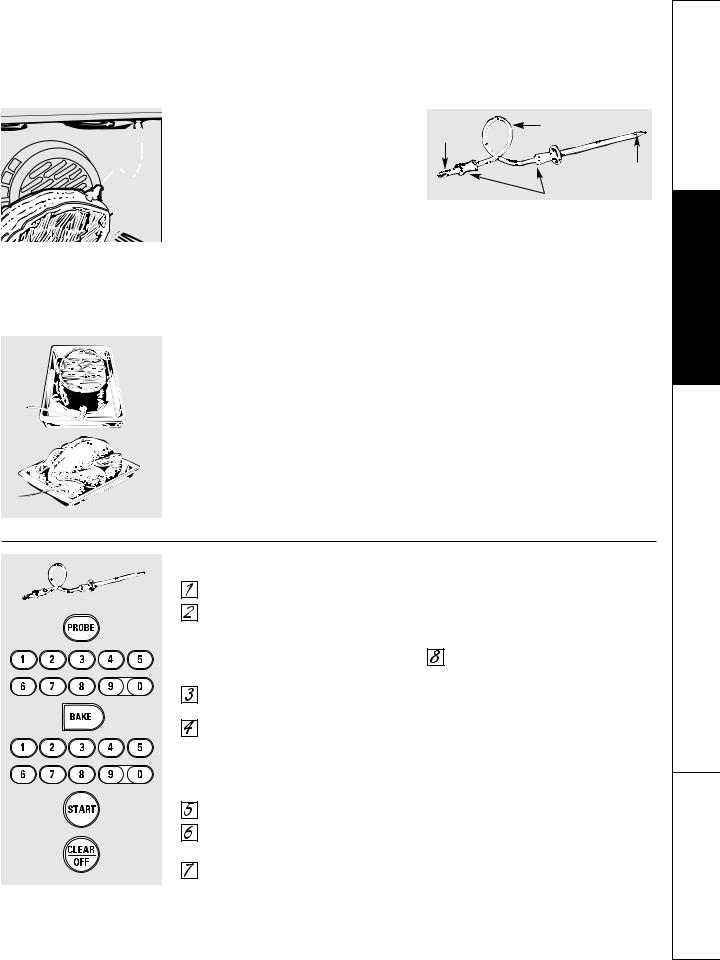
Using the probe. |
ge.com (U.S.) |
www.GEAppliances.ca (Canada) |
|
|
|
For many foods, especially roasts and poultry, internal food temperature is the best test for doneness. The temperature probe takes the guesswork out of roasting by cooking foods to the exact doneness you want.
The temperature probe has a skewer-like probe at one end and a plug at the other end that goes into the outlet in the oven.
Use of probes other than the one provided with this product may result in damage to the probe or oven control.
Use the handles of the probe and plug when inserting and removing them from the food and outlet.
■To avoid damaging your probe, do not use tongs to pull on the cable when removing it.
■To avoid breaking the probe, make sure food is completely defrosted before inserting.
■To prevent possible burns, do not unplug the probe from the outlet until the oven has cooled.
After preparing the meat and placing it on a trivet or a broiler pan grid designed for broiling, follow these directions for proper probe placement.
Insert the probe completely into the meat. It should not touch bone, fat or gristle.
Cable
Plug
Probe
Handles
■Never leave your probe inside the oven during a self-cleaning cycle.
■Do not store the probe in the oven.
For roasts with no bone, insert the probe into the meatiest part of the roast. For bone-in ham or lamb, insert the probe into the center of the lowest large muscle.
Insert the probe into the center of dishes such as meat loaf or casseroles.
Insert the probe into the meatiest part of the inner thigh from below and parallel to the leg of a whole turkey.
How to Set the Oven For Roasting When Using the Probe
Insert the probe into the food.
Plug the probe into the outlet in the oven. Make sure it’s pushed all the way in. Close the oven door. Make sure the probe cable is not touching the broil element.
Touch the PROBE pad.
Touch the number pads to set the desired internal food or meat temperature. The maximum internal temperature for the food that you can set is 200ºF (93°C).
Touch the BAKE pad.
Touch the number pads to set the desired oven temperature.
Touch the START pad.
The display will flash if the probe is inserted into the outlet and you have not set a probe temperature and touched the START pad.
After the internal temperature of the food reaches 100°F (38°C), the
changing internal temperature will be shown inthe display.
When the internal temperature of the food reaches the number you have set, the probe and the oven turn off and the oven control signals. To stop the signal, touch the CLEAR/OFF pad. Use hot pads to remove the probe from the food. Do not use tongs to pull on it—they might damage it.
To change the oven temperature during the Roast cycle, touch the BAKE pad and then the number pads to set the new temperature.
■If the probe is removed from the food before the final temperature is reached, a tone will sound and the display will flash until the probe is removed from the oven.
■You can use the timer even though you
cannot use timed oven operations while |
|
using the probe. |
17 |
|
Support Consumer Tips Troubleshooting Cleaning and Care Instructions Operating Instructions Safety
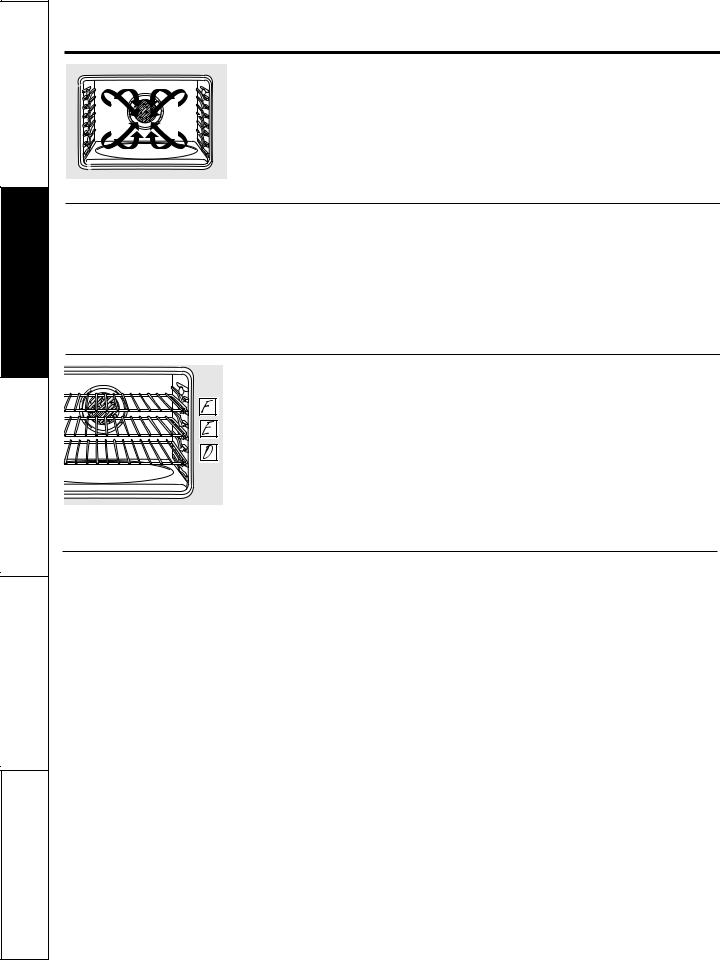
Consumer Support Troubleshooting Tips Care and Cleaning Operating Instructions Safety Instructions
Using the convection oven.
Convection Fan
In a convection oven, a fan circulates hot air over, under and around the food.
This circulating hot air is evenly distributed throughout the oven cavity. As a result, foods are evenly cooked and browned—often in less time with convection heat.
NOTE: The convection fan will cycle on and off while cooking to best distribute hot air in the oven.
The convection oven fan shuts off when the oven door is opened.
1-Rack Convection Baking
The convection fan circulates the heated air evenly over and around the food.
When convection baking with only 1 rack,
use the rack positions recommended in the Using the oven section.
■Ideal for evenly browned baked foods cooked on 1 rack and for large foods. Additionally, some time savings may be noticed.
■Good results with cookies, biscuits, muffins, brownies, cupcakes, cream puffs, sweet rolls, angel food cake and bread.
Multi-rack position.
Multi-Rack Convection Baking
Because heated air is circulated evenly throughout the oven, foods can be baked with excellent results using multiple racks.
Multi-rack baking may increase cook times slightly for some foods, but the overall result is time saved. Cookies, muffins, biscuits, and other quick breads give good results with multi-rack baking.
When baking on 3 racks, place one rack in the fourth (D) position, one in the fifth (E) position and one in the sixth (F) position. If pans will not fit, use rack positions B, D and F.
Adapting Recipes…
You can use your favorite recipes in the convection oven.
When convection baking, the Auto Recipe™ Conversion feature automatically reduces the set regular baking temperature by the recommended 25°F (14°C). See Auto Recipe™ Conversion in the Special Features section.
■Use pan size recommended.
■Some package instructions for frozen casseroles or main dishes have been developed using commercial convection ovens. For best results in this oven, preheat the oven and use the temperature on the package.
18
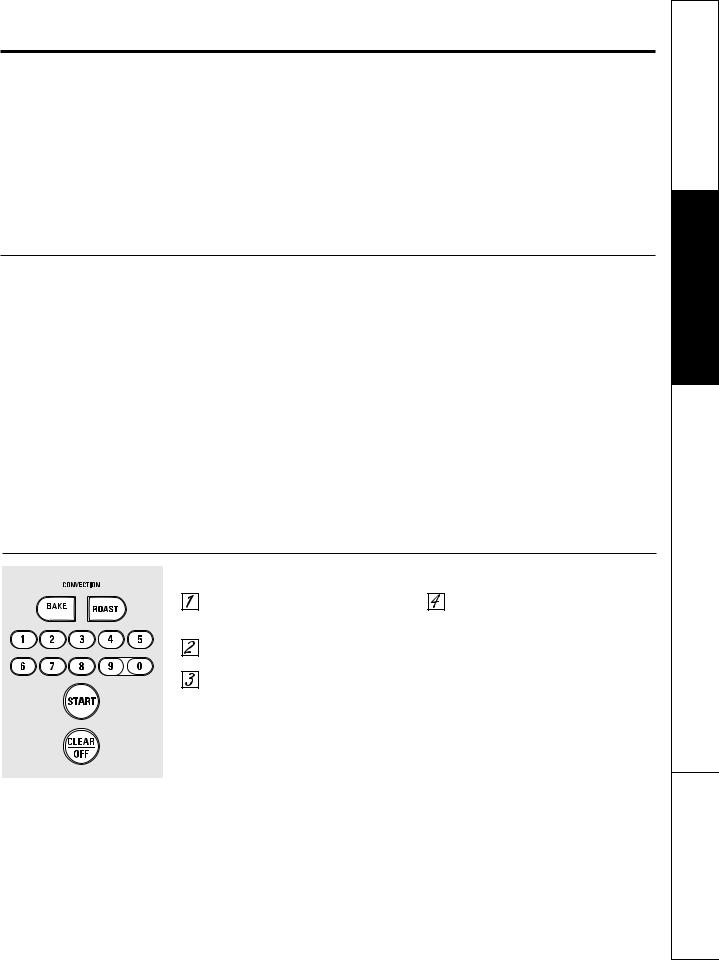
ge.com (U.S.) www.GEAppliances.ca (Canada)
Convection Roast
■ Good for large tender cuts of meat, uncovered.
The convection fan circulates the heated air evenly over and around the food. Meat and poultry are browned on all sides as if they were cooked on a rotisserie. The heated air seals in juices quickly for a moist and tender product while, at the same time, creating a rich golden brown exterior.
When you are convection roasting, it is important that you use a broiler pan and grid designed for broiling for best convection roasting results. The pan is used to catch grease spills and the grid is used to prevent grease spatters.
■Place the oven rack in the position that centers the food between the top and bottom of the oven.
Cookware for Convection Cooking
When baking cookies, you will get the best results if you use a flat cookie sheet instead of a pan with low sides.
Before using your convection oven, check to see if your cookware leaves room for air circulation in the oven.
If you are baking with several pans, leave space between them. Also, be sure the pans do not touch each other or the walls of the oven.
Paper and Plastic
Heat-resistant paper and plastic containers that are recommended for use in regular baking can also be used for convection baking, but should not be used at temperatures higher than the temperature recommended by the
cookware manufacturer. Plastic cookware that is heat-resistant to temperatures of 400°F (204°C) can also be used.
Metal and Glass
Any type of cookware will work in your convection oven. However, metal pans heat the fastest and are recommended for convection baking.
■Darkened or matte-finished pans will bake faster than shiny pans.
■Glass or ceramic pans cook more slowly.
For recipes like oven-baked chicken, use a pan with low sides. Hot air cannot circulate well around food in a pan with high sides.
How to Set the Oven for Convection Baking or Roasting
MULTI/1 RACK OR
Touch the CONVECTION BAKE MULTI/1 RACK or CONVECTION ROAST pad.
Touch the number pads to set the desired oven temperature.
Touch the START pad.
To change the oven temperature, touch the CONVECTION BAKE MULTI/1 RACK or CONVECTION ROAST pad and then the number pads to set the new temperature.
When the oven starts to heat, the changing temperature, starting at 100°F (38°C), will be displayed. When oven reaches the temperature you set, 3 beeps will sound.
Touch CLEAR/OFF pad when finished.
■You will hear a fan while cooking with convection. The fan will stop when the door is opened, but the heat will not turn off.
■You may hear the oven clicking during baking. This is normal.
19
Support Consumer Tips Troubleshooting Cleaning and Care Instructions Operating Instructions Safety
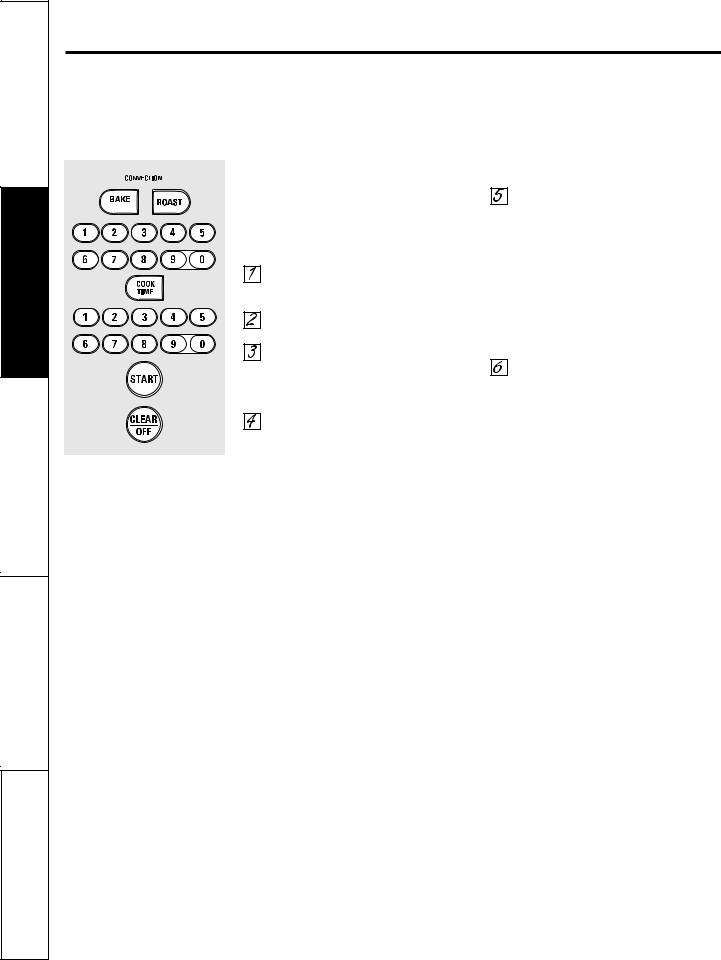
Consumer Support Troubleshooting Tips Care and Cleaning Operating Instructions Safety Instructions
Using the timed features for convection cooking.
You will hear a fan while cooking with these features. The fan will stop when the door is opened, but the heat will not turn off.
NOTE: Foods that spoil easily—such as milk, eggs, fish, stuffings, poultry and pork—should not be allowed to sit for more than 1 hour before or after cooking. Room temperature promotes the growth of harmful bacteria. Be sure that the oven light is off because heat from the bulb will speed harmful bacteria growth.
How to Set an Immediate Start and Automatic Stop
MULTI/1 RACK OR
The oven will turn on immediately and cook for a selected length of time. At the end of the cooking time, the oven will turn off automatically.
Make sure the clock shows the correct time of day.
Touch the CONVECTION BAKE MULTI/1 RACK or CONVECTION ROAST pad.
Touch the number pads to set the desired oven temperature.
Touch the COOK TIME pad.
NOTE: If your recipe requires preheating, you may need to add additional time to the length of the cooking time.
Touch the number pads to set the desired length of cooking time. The minimum cooking time you can set is 1 minute. The oven temperature that you set and the cooking time that you entered will be in the display.
Touch the START pad.
The display will show the changing temperature (starting at 100°F [38°C]) and the cooking time. The display starts changing once the temperature reaches 100°F (38°C).
The oven will continue to cook for the programmed amount of time, then shut off automatically, unless the WARM feature was set. See the How to Set the Oven for Warming section.
Touch the CLEAR/OFF pad to clear the display if necessary. Remove the food from the oven. Remember, even though the oven turns off automatically, food left in the oven will continue cooking after the oven turns off.
20

ge.com (U.S.) www.GEAppliances.ca (Canada)
How to Set a Delayed Start and Automatic Stop
MULTI/1 RACK OR
You can set the oven control to delay-start the oven, cook for a specific length of time and then turn off automatically.
Make sure the clock shows the correct time of day.
Touch the CONVECTION BAKE MULTI/1 RACK or CONVECTION ROAST pad.
Touch the number pads to set the desired oven temperature.
Touch the COOK TIME pad.
NOTE: If your recipe requires preheating, you may need to add additional time to the length of the cooking time.
Touch the number pads to set the desired cooking time.
Touch the DELAY START pad.
Touch the number pads to set the time of day you want the oven to turn on and start cooking.
If you would like to check the times you have set, touch the DELAY START pad to check the start time you have set, or touch the COOK TIME pad to check the length of cooking time you have set.
Touch the START pad.
NOTE: An attention tone will sound if you are using timed baking or roasting and do not touch the START pad after entering the baking or roasting temperature.
When the oven turns on at the time of day you have set, the display will show the changing temperature
(starting at 100°F [38°C]) and the cooking time. The display starts changing once the temperature reaches 100°F (38°C).
The oven will continue to cook for the programmed amount of time, then shut off automatically, unless the WARM feature was set. See the How to Set the Oven for Warming section.
Touch the CLEAR/OFF pad to clear the display if necessary. Remove the food from the oven. Remember, even though the oven shuts off automatically, food left in the oven will continue cooking after the oven turns off.
21
Support Consumer Tips Troubleshooting Cleaning and Care Instructions Operating Instructions Safety

Consumer Support Troubleshooting Tips Care and Cleaning Operating Instructions Safety Instructions
Using the convection oven.
For best results when roasting large turkeys and roasts, we recommend using the probe included in the convection oven.
To change the oven temperature during the Convection Roast cycle, touch the CONVECTION ROAST pad and then touch the number pads to set the new desired temperature.
22
How to Set the Oven for Convection Roasting when Using the Probe
The display will flash PROBE and the oven control will signal if the probe is inserted into the outlet, and you have not set a probe temperature and pressed the
START pad.
Place the oven rack in the position that centers the food between the top and bottom of the oven. Insert the probe into the meat.
Plug the probe into the outlet in the oven. Make sure it is pushed all the way in. Close the oven door.
Touch the CONVECTION ROAST pad.
Touch the number pads to set the desired oven temperature.
Touch the PROBE pad.
Touch the number pads to set the desired internal meat temperature.
Touch the START pad.
When the oven starts to heat, the word LO will be in the display.
After the internal temperature of the meat reaches 100°F (38°C), the changing internal temperature will be shown in the display.
When the internal temperature of the meat reaches the number you have set, the probe and the oven turn off and the oven control signals. To stop the signal, touch the CLEAR/OFF pad. Use hot pads to remove the probe from the food. Do not use tongs to pull on it—they might damage it.
CAUTION: To prevent possible burns, do not unplug the probe from the oven outlet until the oven has cooled. Do not store the probe in the oven.
NOTE:
■If the probe is removed from the food before the final temperature is reached, a tone will sound and the display will flash until the probe is removed from the oven.
■You will hear a fan while cooking with this feature. The fan will stop when the door is opened, but the heat will not turn off.
■You can use the kitchen timer even though you cannot use timed oven operations.
Convection Roasting Guide
|
|
|
Minutes/Lb. |
|
|
Meats |
|
|
(Minutes/kg) |
Oven Temp. |
Internal Temp. |
Beef |
Rib, Boneless Rib, |
Rare |
20–24 (44–53) |
325°F (163°C) |
140°F (60°C)† |
|
Top Sirloin |
Medium |
24–28 (53–62) |
325°F (163°C) |
160°F (71°C) |
|
(3 to 5 lbs. [1.36 kg to 2.27 kg]) |
Well |
28–32 (62–71) |
325°F (163°C) |
170°F (77°C) |
|
Beef Tenderloin |
Rare |
10–14 (22–31) |
325°F (163°C) |
140°F (60°C)† |
|
|
Medium |
14–18 (31–40) |
325°F (163°C) |
160°F (71°C) |
Pork |
Bone-In, Boneless (3 to 5 lbs. |
|
23–27 (51–60) |
325°F (163°C) |
170°F (77°C) |
|
[1.36 kg to 2.27 kg]) |
|
|
|
|
|
Chops (1/2 to 1″ |
2 chops |
30–35 (66–77) total |
325°F (163°C) |
170°F (77°C) |
|
[1.3 cm to 2.5 cm] thick) |
4 chops |
35–40 (77–88) total |
325°F (163°C) |
170°F (77°C) |
|
|
6 chops |
40–45 (88–99) total |
325°F (163°C) |
170°F (77°C) |
Ham |
Canned, Butt, Shank (3 to 5 lbs. |
|
14–18 (31–40) |
325°F (163°C) |
140°F (60°C) |
|
[1.36 kg to 2.27 kg] fully cooked) |
|
|
|
|
Lamb |
Bone-In, Boneless (3 to 5 lbs. |
Medium |
17–20 (37–44) |
325°F (163°C) |
160°F (71°C) |
|
[1.36 kg to 2.27 kg]) |
Well |
20–24 (44–53) |
325°F (163°C) |
170°F (77°C) |
Seafood |
Fish, Whole (3 to 5 lbs. [1.36 kg to 2.27 kg]) |
30–40 (66–88) total |
400°F (204°C) |
|
|
|
Lobster Tails (6 to 8 oz. [170 g to 227 g] each) |
20–25 (44–55) total |
350°F (177°C) |
|
|
Poultry |
Whole Chicken (21⁄2 to 31⁄2 lbs. |
|
24–26 (53–57) |
350°F (177°C) |
180°–185°F (82°–85°C) |
|
[1.13 kg to 1.59 kg]) |
|
|
|
|
|
Cornish Hens, Unstuffed (1 to 11⁄2 lbs. |
|
50–55 |
350°F (177°C) |
180°–185°F (82°–85°C) |
|
[0.45 kg to 0.68 kg]) |
|
(110–121) total |
|
|
|
Stuffed (1 to 11⁄2 lbs. |
|
55–60 |
350°F (177°C) |
180°–185°F (82°–85°C) |
|
[0.45 kg to 0.68 kg]) |
|
(121–132) total |
|
|
|
Duckling (4 to 5 lbs. [1.81 kg to 2.27 kg]) |
24–26 (53–57) |
325°F (163°C) |
180°–185°F (82°–85°C) |
|
|
Turkey, Whole* |
|
|
|
|
|
Unstuffed (10 to 16 lbs. [4.54 kg to 7.26 kg]) |
8–11 (18–24) |
325°F (163°C) |
180°–185°F (82°–85°C) |
|
|
Unstuffed (18 to 24 lbs. [8.16 kg to 10.89 kg]) |
7–10 (15–22) |
325°F (163°C) |
180°–185°F (82°–85°C) |
|
|
Turkey Breast (4 to 6 lbs. [1.81 kg to 2.72 kg]) |
16–19 (35–42) |
325°F (163°C) |
170°F (77°C) |
|
|
|
|
|
|
|
*Stuffed birds generally require 30–45 minutes additional roasting time. Shield legs and breast with foil to prevent overbrowning and drying of skin.
†The U.S. Department of Agriculture says “Rare beef is popular, but you should know that cooking it to only 140°F (60°C) means some food poisoning organisms may survive.” (Source: Safe Food Book. Your Kitchen Guide. USDA Rev. June 1985.)
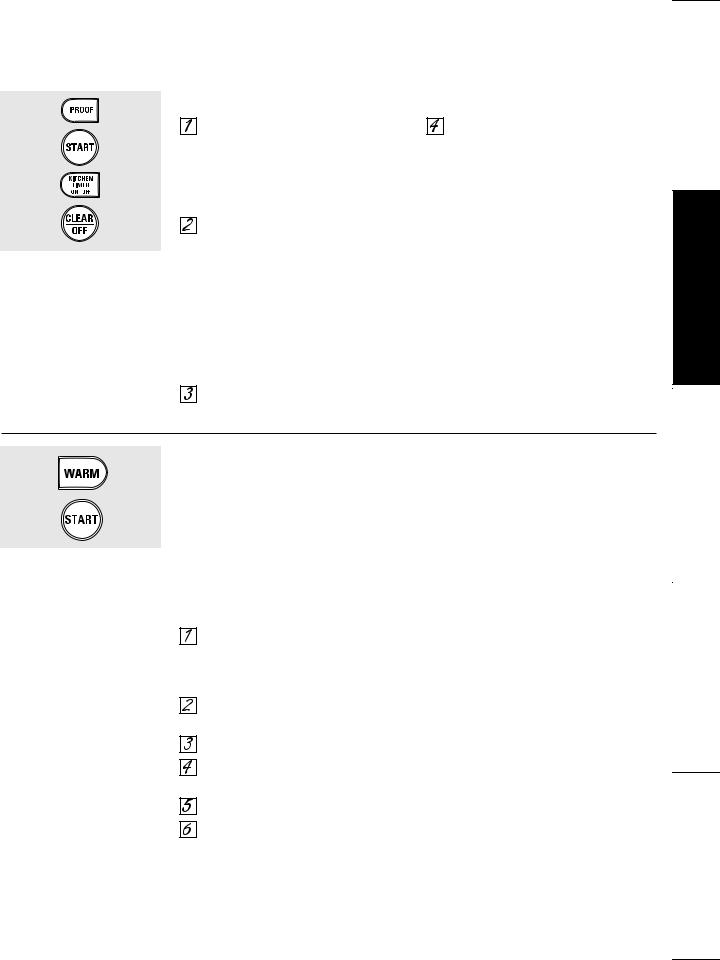
Using the proofing and warming features. |
ge.com (U.S.) |
www.GEAppliances.ca (Canada) |
|
|
|
The proofing feature maintains a warm environment useful for rising yeast-leavened products.
How to Set the Oven For Proofing
Place the covered dough in a dish in the oven on shelf B or C.
NOTE: For best results, cover the dough with a cloth or with greased plastic wrap (the plastic may need to be anchored underneath the container so the oven fan will not blow it off).
Touch the PROOF pad and then the
START pad.
The display will read PrF (proof).
The oven interior light turns on and remains on during proofing.
The proofing feature automatically provides the optimum temperature for the proofing process, and therefore does not have a temperature adjustment.
Set the KITCHEN TIMER ON/OFF for the minimum proof time.
When proofing is finished, touch the CLEAR/OFF pad.
■To avoid lowering the oven temperature and lengthening proofing time, do not open the oven door unnecessarily.
■Check bread products early to avoid over-proofing.
NOTE:
■Do not use the proofing mode for warming food or keeping food hot. The proofing oven temperature is not hot enough to hold foods at safe temperatures. Use the WARM feature to keep food warm.
■Proofing will not operate when oven is above 125°F (52°C). “HOT” will show in the display.
How to Set the Oven For Warming
The WARM feature keeps cooked foods hot.
This feature is not designed to reheat cold food.
To use the WARM feature, touch the WARM pad and then the START pad.
To use the WARM feature after Timed Baking or Roasting, follow these steps:
Touch the mode of cooking that you want to use (BAKE, CONVECTION BAKE MULTI/1 RACK, or CONVECTION ROAST).
Touch the number pads to set the oven temperature.
Touch the COOK TIME pad.
Touch the number pads to set the desired length of cooking time.
Touch the WARM pad.
Touch the START pad.
To Crisp Stale Items
■Place food in low-sided dishes or pans.
■For best results, place the food items in a single layer. Do not stack.
■Leave them uncovered.
■Check crispness after 20–30 minutes. Add time as needed.
IMPORTANT NOTES:
■Food should be kept hot in its cooking container or transferred to a heat-safe serving dish.
■For moist foods, cover them with an oven-safe lid or aluminum foil.
■Fried or crisp foods do not need to be covered, but can become too dry if warmed for too long.
■Repeated opening of the door allows the hot air to escape and the food to cool.
■Allow extra time for the temperature inside the oven to stabilize after adding items.
■With large loads it may be necessary to cover some of the cooked food items.
■Remove serving spoons, etc., before placing containers in the oven.
■Do not use plastic containers, lids or plastic wrap.
CAUTION:Plastic containers, lids or plastic wrap will melt if placed in the oven.
Melted plastic may not be removable and is not covered under your warranty.
23
Support Consumer Tips Troubleshooting Cleaning and Care Instructions Operating Instructions Safety

Consumer Support Troubleshooting Tips Care and Cleaning Operating Instructions Safety Instructions
Adjust the oven thermostat—Do it yourself!
You may find that your new oven cooks differently than the one it replaced. Use your new oven for a few weeks to become more familiar with it. If you still think your new oven is too hot or too cold, you can adjust the thermostat yourself.
Do not use thermometers, such as those found in grocery stores, to check the temperature setting of your oven. These thermometers may vary 20–40 degrees F (11–22 degrees C).
NOTE: This adjustment will only affect baking and roasting temperatures; it will not affect broiling, convection or self-cleaning temperatures. The adjustment will be retained in memory after a power failure.
To Adjust the Thermostat
+
Touch the BROIL HI/LO and BAKE pads at the same time for 3 seconds until the display shows SF.
Touch the BAKE pad. A two-digit number shows in the display.
Touch BAKE again to alternate between increasing and decreasing the oven temperature.
The oven temperature can be adjusted up to (+) 35ºF (19°C) hotter or (-) 35ºF (19°C) cooler. Touch the number pads the same way you read them. For example, to change the oven temperature 15ºF (8°C), touch 1 and 5.
When you have made the adjustment, touch the START pad to go back to the time of day display. Use your oven as you would normally.
The type of margarine will affect baking performance!
Most recipes for baking have been developed using high-fat products such as butter or margarine (80% fat). If you decrease the fat, the recipe may not give the same results as with a higher-fat product.
Recipe failure can result if cakes, pies, pastries, cookies or candies are made with low-fat spreads. The lower the fat content of a spread product, the more noticeable these differences become.
U.S. federal standards require products labeled “margarine” to contain at least 80% fat by weight. Low-fat spreads, on the other hand, contain less fat and more water. The high moisture content of these spreads affects the texture and flavor of baked goods. For best results with your old favorite recipes, use margarine, butter or stick spreads containing at least 70% vegetable oil.
24
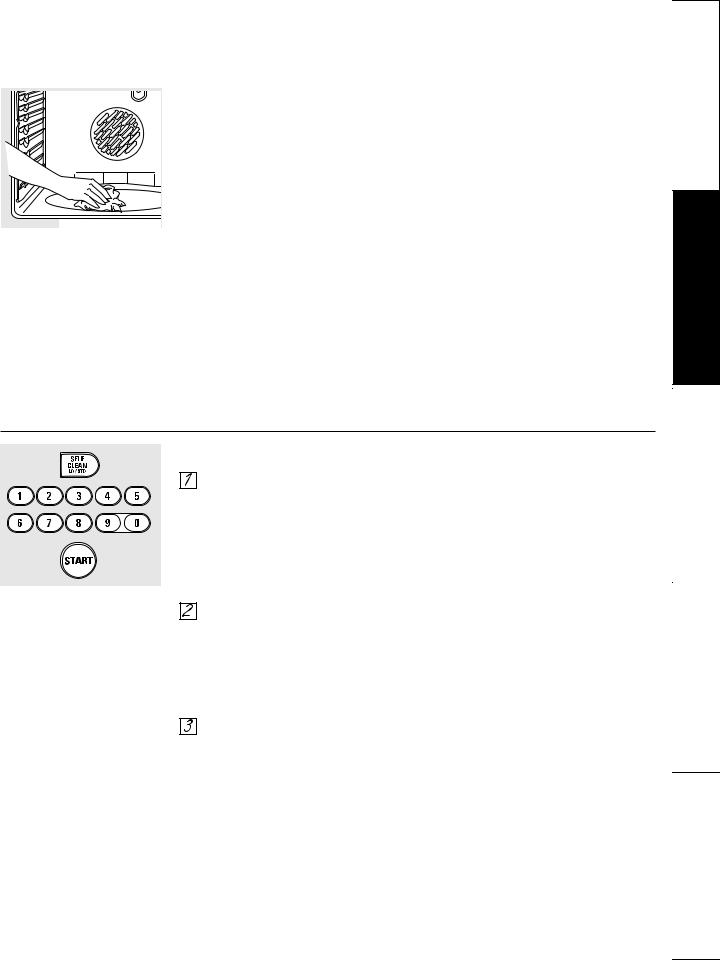
Using the self-cleaning oven. |
ge.com (U.S.) |
www.GEAppliances.ca (Canada) |
The oven door must be closed and all controls set correctly for the cycle to work properly.
Wipe up heavy soil on the oven bottom.
Before a Clean Cycle
We recommend venting your
kitchen with an open window or using a ventilation fan or hood during the first self-clean cycle.
Remove racks, broiler pan, broiler grid, probe, all cookware and any aluminum foil from the oven.
The shiny, silver-colored oven racks (on some models) can be self-cleaned, but they will darken, lose their luster and become hard to slide.
Soil on the front frame of the range and outside the gasket on the door will need to be cleaned by hand. Clean these areas with hot water, soap-filled or plastic scouring pads or cleansers such as Soft Scrub®. Rinse well with clean water
and dry.
Do not clean the gasket. The fiberglass material of the oven door gasket cannot withstand abrasion. It is essential for the gasket to remain intact. If you notice it becoming worn or frayed, replace it.
Wipe up any heavy spillovers on the oven bottom.
Make sure the oven light bulb cover is in place and the oven light is off.
IMPORTANT: The health of some birds is extremely sensitive to the fumes given off during the self-cleaning cycle of any range. Move birds to another wellventilated room.
How to Set the Oven for Cleaning
Touch the SELF CLEAN LO/STD pad once for a 4-hour clean time or twice for a 3-hour clean time.
A 3-hour self-clean time is recommended for use when cleaning small, contained spills. A self-clean time of 4 hours or longer is recommended for a dirtier oven.
If a time other than 4 hours or
3 hours is needed, use the number pads and enter the desired clean time.
You can change the clean time to any time between 3 hours and 5 hours, depending on how dirty your oven is.
Touch the START pad.
The door locks automatically. The display will show the clean time remaining. It will not be possible to open the oven door until the temperature drops below the lock temperature and the LOCKED light goes off.
When the LOCKED light goes off, you will be able to open the door.
■The word LOCKED will flash and the oven control will signal if you set the clean cycle and forget to close the oven door.
■To stop a clean cycle, touch the CLEAR/OFF pad. When the LOCKED light goes off indicating the oven has cooled below the locking temperature, you will be able to open the door.
25
Support Consumer Tips Troubleshooting Cleaning and Care Instructions Operating Instructions Safety
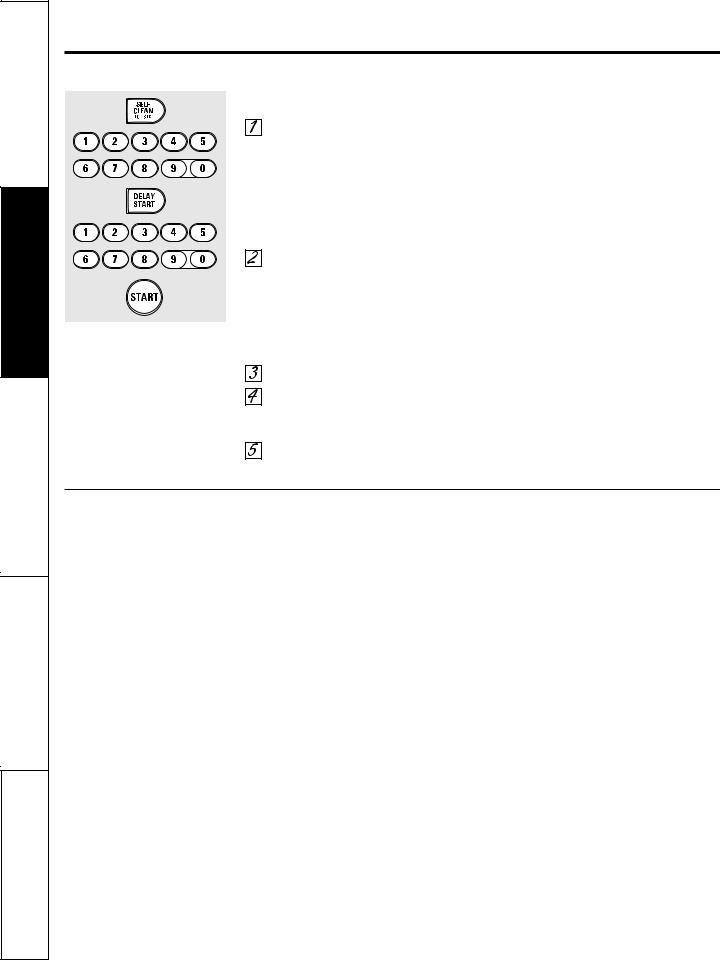
Consumer Support Troubleshooting Tips Care and Cleaning Operating Instructions Safety Instructions
Using the self-cleaning oven.
The oven door must be closed and all controls must be set correctly for the cycle to work properly.
How to Delay the Start of Cleaning
Touch the SELF CLEAN LO/STD pad once for a 4-hour clean time or twice for a 3-hour clean time.
A 3-hour self-clean time is recommended for use when cleaning small, contained spills. A self-clean time of 4 hours or longer is recommended for a dirtier oven.
If a time other than 4 hours or
3 hours is needed, use the number pads and enter the desired clean time.
You can change the clean time to any time between 3 hours and 5 hours, depending on how dirty your oven is.
Touch the DELAY START pad.
Using the number pads, enter the time of day you want the clean cycle to start.
Touch the START pad.
The door locks automatically. The display will show the start time. It will not be possible to open the oven door until
the temperature drops below the lock temperature and the LOCKED light goes off.
When the LOCKED light goes off, you will be able to open the door.
After a Clean Cycle
You may notice some white ash in the oven. Wipe it up with a damp cloth after the oven cools.
If white spots remain, remove them with a soapfilled or plastic scouring pad and rinse thoroughly with a vinegar and water mixture.
These deposits are usually a salt residue that cannot be removed by the clean cycle.
If the oven is not clean after one clean cycle, repeat the cycle.
■You cannot set the oven for cooking until the oven is cool enough for the door to unlock.
■While the oven is self-cleaning, you can touch the CLOCK pad to display the time of day. To return to the clean countdown, touch the SELF CLEAN LO/STD pad.
■If the racks become hard to slide, apply a small amount of cooking oil to a paper towel and wipe the edges of the oven racks with the paper towel.
26
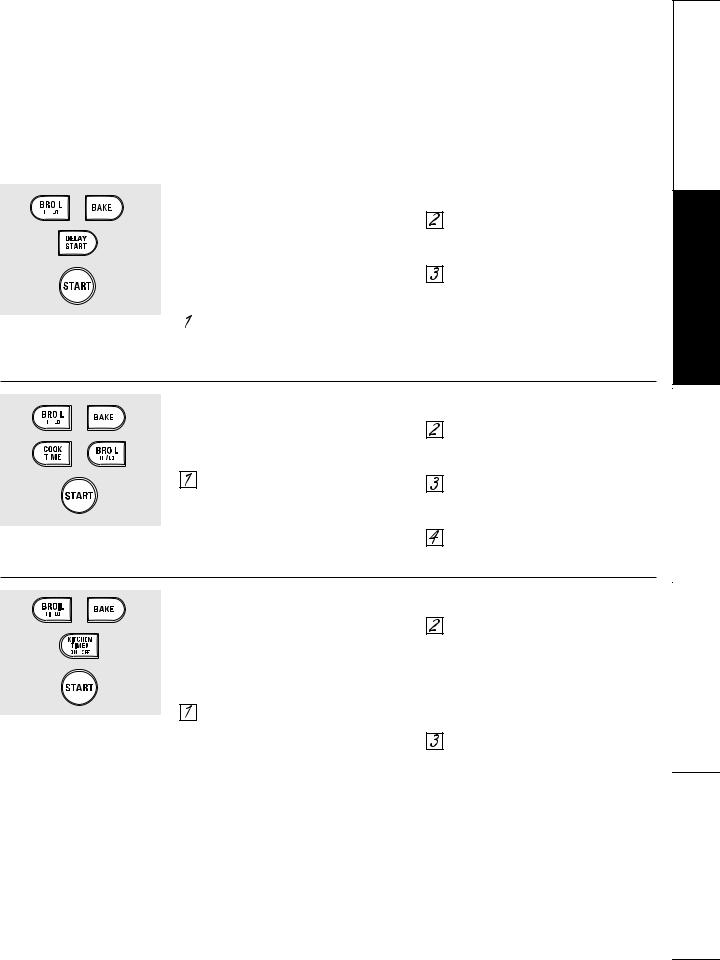
Special features of your oven control. |
ge.com (U.S.) |
www.GEAppliances.ca (Canada) |
Your new touch pad control has additional features that you may choose to use. The following are the features and how you may activate them.
The special feature modes can only be activated while the display is showing the time of day. They remain in the control’s memory until the steps are repeated.
When the display shows your choice, touch the START pad. The special features will remain in memory after a power failure, except for the Sabbath feature, which will have to be reset.
12-Hour Shutdown
|
+ |
With this feature, should you forget and leave the |
||
|
||||
|
||||
|
|
|||
|
|
oven on, the control will automatically turn off the |
||
|
|
oven after 12 hours during baking functions or |
||
|
|
after 3 hours during a broil function. |
||
|
|
If you wish to turn OFF this feature, follow |
||
|
|
the steps below. |
||
|
|
|
|
Touch the BROIL HI/LO and BAKE |
|
|
|
|
|
|
|
|
|
pads at the same time for 3 seconds |
|
|
|
|
|
|
|
|
|
until the display shows SF. |
Touch the DELAY START pad until no shdn (no shut-off) appears in the display.
Touch the START pad to activate the no shut-off and leave the control set in this special features mode.
Fahrenheit or Celsius Temperature Selection
|
+ |
|
|
Your oven control is set to use the Fahrenheit |
Touch the COOK TIME and BROIL |
|
|
||||
|
|
||||
|
|
|
|
||
|
+ |
|
|
temperature selections but you may change this |
HI/LO pads at the same time. The |
|
|
|
to use the Celsius selections. |
display will show F (Fahrenheit). |
|
|
|
||||
|
|
|
|||
|
|
|
|
Touch the BROIL HI/LO and BAKE |
Touch the COOK TIME and BROIL |
|
|
|
|
pads at the same time for 3 seconds |
HI/LO pads again at the same time. |
|
|
|
|
until the display shows SF. |
The display will show C (Celsius). |
Touch the START pad.
Tones at the End of a Timed Cycle
+
At the end of a timed cycle, 3 short beeps will sound followed by one beep every 6 seconds until the CLEAR/OFF pad is touched. This continual 6-second beep may be canceled.
To cancel the 6-second beep:
Touch the BROIL HI/LO and BAKE pads at the same time for 3 seconds until the display shows SF.
Touch the KITCHEN TIMER ON/OFF pad. The display shows CON BEEP (continuous beep). Touch the
KITCHEN TIMER ON/OFF pad again. The display shows BEEP. (This cancels the one beep every 6 seconds.)
Touch the START pad.
27
Support Consumer Tips Troubleshooting Cleaning and Care Instructions Operating Instructions Safety
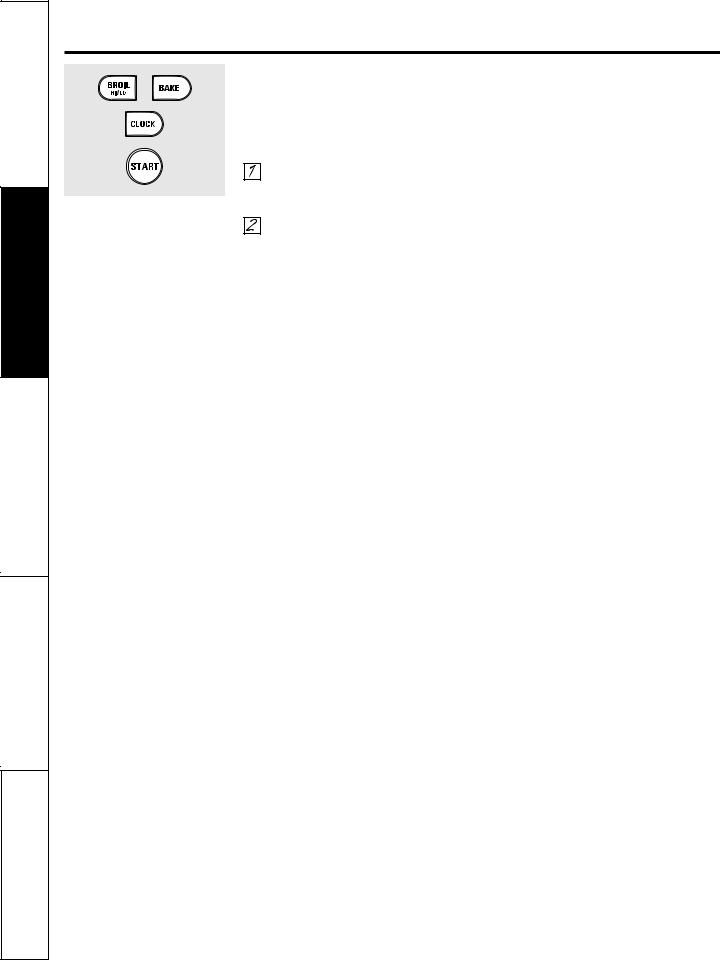
Consumer Support Troubleshooting Tips Care and Cleaning Operating Instructions Safety Instructions
Special features of your oven control.
+ |
12-Hour, 24-Hour or Clock Blackout |
Your control is set to use a 12-hour clock. |
If you would prefer to have a 24-hour military time clock or black out the clock display, follow the steps below.
Touch the BROIL HI/LO and BAKE pads at the same time for 3 seconds until the display shows SF.
Touch the CLOCK pad once. The display will show 12 hr. If this is the choice you want, touch the
START pad.
Touch the CLOCK pad again to change to the 24 hour military time clock. The display will show 24 hr. If this is the choice you want, touch the START pad.
Touch the CLOCK pad again to black out the clock display. The display will show OFF. If this is the choice you want, touch the START pad.
NOTE: If the clock is in the black-out mode you will not be able to use the Delay Start function.
28
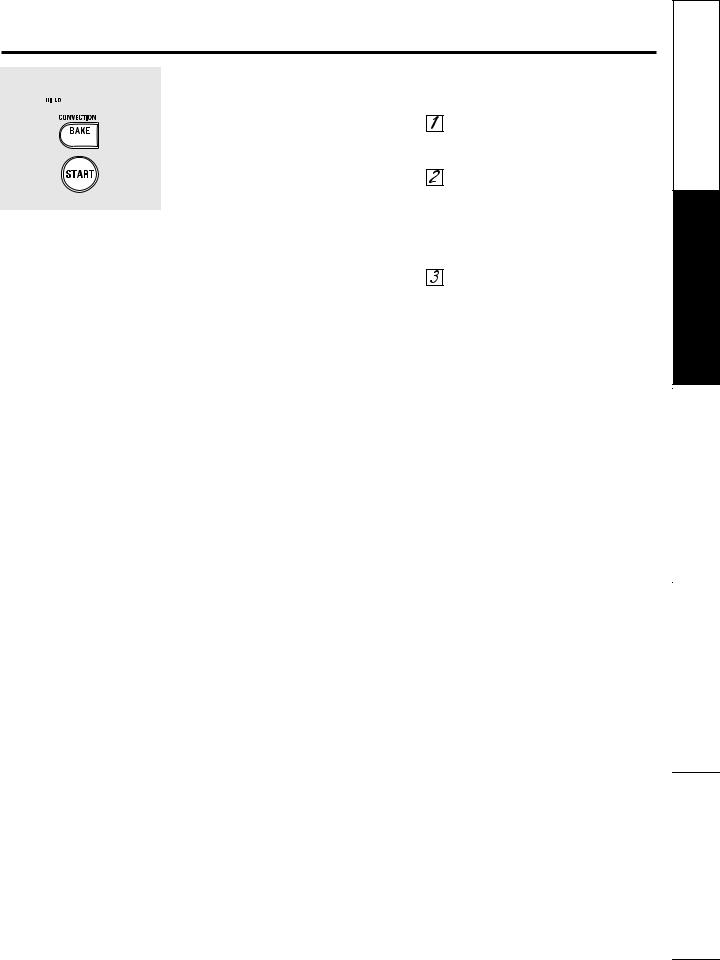
ge.com (U.S.) www.GEAppliances.ca (Canada)
 +
+ 
MULTI/1 RACK
Using Auto Recipe™ Conversion
When using convection bake, the Auto Recipe™ Conversion feature will automatically convert entered regular baking temperatures to convection baking temperatures.
The display will show the actual converted (reduced) temperature. For example, if you enter a regular recipe temperature of 350°F (177°C) and touch the START pad, the display will show CON and the converted temperature of 325°F (163°C).
NOTE: This feature only converts cooking temperatures, not cooking times.
To turn off this feature:
Touch the BROIL HI/LO and BAKE pads at the same time for 3 seconds until the display shows SF.
Touch the CONVECTION BAKE MULTI/1 RACK pad. The display will show CON ON. Touch the
CONVECTION BAKE MULTI/1 RACK pad again. The display will show
CON OFF.
Touch the START pad.
To turn on this feature, repeat steps 1–3 above but touch the START pad when CON ON is in the display.
29
Support Consumer Tips Troubleshooting Cleaning and Care Instructions Operating Instructions Safety
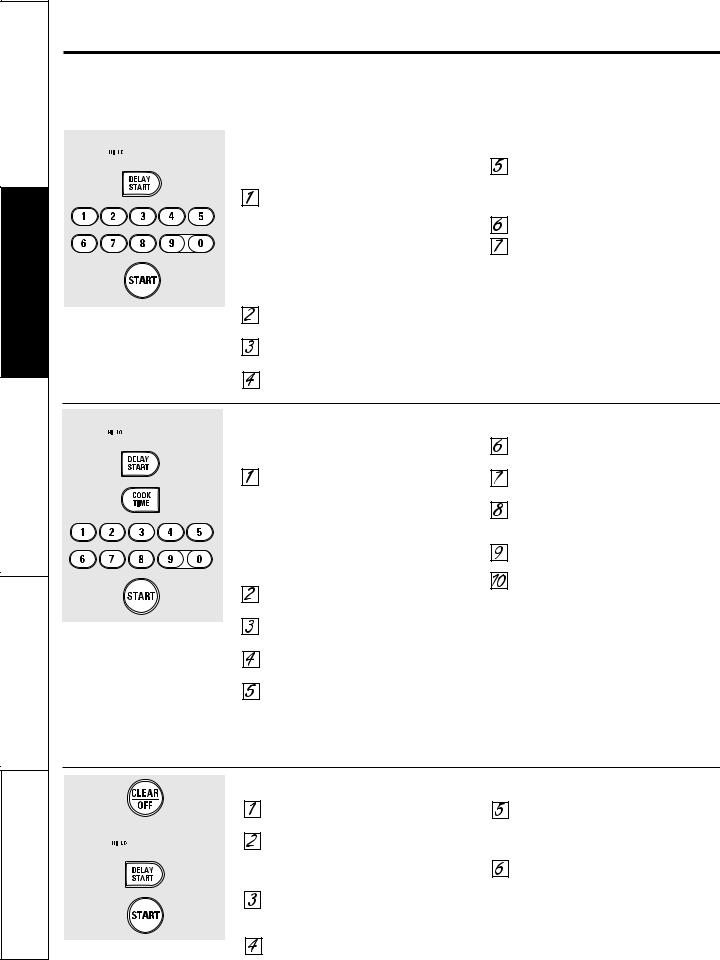
Consumer Support Troubleshooting Tips Care and Cleaning Operating Instructions Safety Instructions
Using the Sabbath Feature.
(Designed for use on the Jewish Sabbath and Holidays.) (on some models)
The Sabbath feature can be used for baking/roasting only. It cannot be used for convection, broiling, self-cleaning or Delay Start cooking.
NOTE: The oven light comes on automatically when the door is opened and goes off when the door is closed. The bulb may be removed. See the Oven Light Replacement section. On models with a light switch on the control panel, the oven light may be turned on and left on.
 +
+ 
When the display shows the oven is set in Sabbath. When the display shows the oven is baking/roasting.
How to Set for Regular Baking/Roasting
Make sure the clock shows the correct time of day and the oven is off.
Touch and hold both the BROIL HI/LO and BAKE pads, at the same time, until the display shows SF.
NOTE: If bake or broil appears in the display, the BROIL HI/LO and BAKE pads were not touched at the same time. Touch the CLEAR/OFF pad and begin again.
Tap the DELAY START pad until SAb bAtH appears in the display.
Touch the START pad and will appear in the display.
Touch the BAKE pad. No signal will be given.
Using the number pads, enter the desired temperature between 170°F (77°C) and 550°F (288°C). No signal or temperature will be given.
Touch the START pad.
After a random delay period of approximately 30 seconds to 1 minute,will appear in the display indicating that the oven is baking/ roasting. If doesn’t appear in the display, start again at Step 4.
To adjust the oven temperature, touch the BAKE pad, enter the new temperature using the number pads and touch the START pad.
NOTE: The CLEAR/OFF and COOK TIME pads will function during the Sabbath feature.
 +
+ 
When the display shows the oven is set in Sabbath. When the display shows the oven is baking/roasting.
How to Set for Timed Baking/Roasting – Immediate Start and Automatic Stop
Make sure the clock shows the correct time of day and the oven is off.
Touch and hold both the BROIL HI/LO and
BAKE pads, at the same time, until the display shows SF.
NOTE: If bake or broil appears in the display, the BROIL HI/LO and BAKE pads were not touched at the same time. Touch the CLEAR/OFF pad and begin again.
Tap the DELAY START pad until SAb bAtH appears in the display.
Touch the START pad and will appear in the display.
Touch the COOK TIME pad.
Touch the number pads to set the desired length of cooking time between 1 minute and 9 hours and 99 minutes. The cooking time that you entered will be displayed.
Touch the START pad.
Touch the BAKE pad. No signal will be given.
Using the number pads, enter the desired temperature. No signal or temperature will be given.
Touch the START pad.
After a random delay period of approximately 30 seconds to 1 minute,will appear in the display indicating that the oven is baking/roasting. If doesn’t appear in the display, start again at Step 7.
To adjust the oven temperature, touch the BAKE pad, enter the new temperature using the number pads and touch the START pad.
When cooking is finished, the display will change from to and 0:00 will appear, indicating that the oven has turned OFF but is still set in Sabbath. Remove the cooked food.
How to Exit the Sabbath Feature
 +
+ 
30
Touch the CLEAR/OFF pad.
If the oven is cooking, wait for a random delay period of approximately 30 seconds to 1 minute, until only
is in the display.
Touch and hold both the BROIL HI/LO and BAKE pads, at the same time, until the display shows SF.
Tap the DELAY START pad until 12 shdn or no shdn appears in the display.
Choose 12 shdn, indicating that the oven will automatically turn off after 12 hours or no shdn, indicating that the oven will not automatically turn off after 12 hours.
Touch the START pad when the option that you want is in the display (12 shdn or no shdn).
NOTE: If a power outage occurred while the oven was in Sabbath, the oven will automatically turn off and stay off even when the power returns. The oven control must be reset.
